
- Forum Listing
- Marketplace
- Advanced Search
- Subwoofers, Bass, and Transducers

Diameter VS high excursion
- Add to quote
Hello, Do you think it's better a big sub with low excurtion, or a smaller one, but with high excursion? For example, do you prefer a 15" with xmax of 5 mm or a 8" with 50 mm xmax?
I want more excursion. A 15" driver with a 25mm excursion will catch my attention every day. Personally, I don't think a 15" driver with a 5mm excursion is noteworthy. Is this a driver you're looking to purchase? As an example, here's a 4 Ohm, 15" driver with a 14mm excursion one can purchase from Parts-Express. Dayton Audio RSS390HF-4 15" The least expensive driver has an Xmax of 8.4mm.
ideally there is a balance. For example at some point usually around 30mm Xmax one way you start running out of benefit for a reasonable cost by trying trying to increase xmax anymore. Also you need to consider that at certain point xmax doesn't matter sense higher frequencies upper bass for example is about surface area of a driver ,number of drivers, power handling ,and power the amplifier can deliver. Your given example doesn't make sense getting a driver to 50mm xmax one way is waste of time. It can be done but it will very expensive and you might consider more drivers or a big driver. In general driver size isn't a choice. Driver size is usually dictated by box size, power available, budget and generally the type of subwoofer you want to make (sealed , ported ,horn, ecte) and again size. For example generally the biggest quality driver makes sense. But for example many don't use 18's because their really big and require a lot of box size. So for example people might use two 15 inch drivers to get in the same ballpark of surface area.
It also seems like it is easier to make a larger driver with good excursion than a small driver with good excursion. Usually larger drivers from the same product line will have more excursion, i'm not sure if that is just a result of larger parts in general? And while we're on the topic has anyone tracked down some info on the balance between excursion and surface area? For example if driver a) is twice the size of driver b) but driver b) has twice the excursion of driver a) will they both be capable of the same spl, all things being equal, or does it scale differently?
Quote: Originally Posted by Mik James /t/1477173/diameter-vs-high-excursion#post_23424870 And while we're on the topic has anyone tracked down some info on the balance between excursion and surface area? For example if driver a) is twice the size of driver b) but driver b) has twice the excursion of driver a) will they both be capable of the same spl, all things being equal, or does it scale differently? Click to expand...
Quote: Originally Posted by SystemHDS /t/1477173/diameter-vs-high-excursion#post_23424511 Hello, Do you think it's better a big sub with low excurtion, or a smaller one, but with high excursion? Click to expand...
Quote: This calculator is for a sealed box but, regarding an answer for what you're asking about in your above, it might give you ideas. Click to expand...
Quote: Originally Posted by Mik James /t/1477173/diameter-vs-high-excursion#post_23425310 Answered both the question I asked and another regarding frequency and excursion. Thanks Click to expand...
If i want to have a lot of punch between 50-80 Hz, what type of subwoofer are suitable? A 10" driver can have the same energy at punch frequencies as a 15" or 18"?
Quote: Originally Posted by SystemHDS /t/1477173/diameter-vs-high-excursion#post_23426620 A 10" driver can have the same energy at punch frequencies as a 15" or 18"? Click to expand...
Quote: Originally Posted by SystemHDS /t/1477173/diameter-vs-high-excursion#post_23426620 If i want to have a lot of punch between 50-80 Hz, what type of subwoofer are suitable? A 10" driver can have the same energy at punch frequencies as a 15" or 18"? Click to expand...
i'd like to know what type of subwoofers have a lot of punch, and what parameters are needed to get it. For example, if the amplifier must have a good damping factor, or slew rate, ecc..
Quote: Originally Posted by SystemHDS /t/1477173/diameter-vs-high-excursion#post_23427253 For example, if the amplifier must have a good damping factor, or slew rate, ecc.. Click to expand...
I have 2 mid-priced Velodyne 10" DSP ported subs in my medium size HT room. The EQ-Max 10 would be the equivalent now I guess. They provide me with perfectly fine LFE with lots of impact that gives me a great HT experience. In fact, unlike many here & perhaps because I'm now an old phart, I wouldn't want anymore performance because I find that often soundtracks are way over done and really don't correlate to what I see on my 55" screen. When I first ran Audyssey, I had set the subs' volumes at 4 of 10. That proved to be way too high and eventually after some tweaking, they are now set at 2 of 10 that brings them nicely into the middle of Audyssey's correction range. They produce sound down to 23 Hz and still create room effects - buzzing & rattling - in my room down to 20 Hz, although nothing is audible. I find that the vibrations and noises produced by my metal gas fireplace and furnace ducting in the walls & ceilings are quite annoying - like a rattle or squeak in my car. In my audio-only tube amp sats/subs system, I have 2 EP400 8" sealed DSP 500W/CH subs that are wonderfully articulate and are absolutely stunning for music. No towers that I auditioned within a reasonable price range equaled the performance of this smallish setup. For me, smaller is better... TAM
Quote: Originally Posted by SystemHDS /t/1477173/diameter-vs-high-excursion#post_23424511 Hello, Do you think it's better a big sub with low excurtion, or a smaller one, but with high excursion? For example, do you prefer a 15" with xmax of 5 mm or a 8" with 50 mm xmax? Click to expand...
Quote: Originally Posted by SystemHDS /t/1477173/diameter-vs-high-excursion#post_23427253 i'd like to know what type of subwoofers have a lot of punch, and what parameters are needed to get it. Click to expand...
- ?
- 34.1M posts
- 1.5M members
Top Contributors this Month
Tax Return Sale Will End Soon: Get 15% off, sitewide.
Offer ends in
Free U.S. Shipping from Miami, FL, USA

- 1-Channel Full Range Amplifiers
- 1-Channel Amplifiers for Subwoofers
- 2-Channel Amplifiers
- 4-Channel Amplifiers
- 5-Channel Amplifiers
- 6-Channel Amplifiers
- View All Amplifiers
- 6" Subwoofers
- 8" Subwoofers
- 10" Subwoofers
- 12" Subwoofers
- 15" Subwoofers
- Subwoofers Enclosures
- View All Subwoofers
- 3.5" Coaxials
- 4" Coaxials
- 4x6" Coaxials
- 5.25" Coaxials
- 5x7" Coaxials
- 6.5" Coaxials and Components
- 6x9" Coaxials
- View All Coaxials and Components
- 4" Loudspeakers
- 5.25" Loudspeakers
- 6.5" Loudspeakers
- 6x9" Loudspeakers
- 8" Loudspeakers
- 10" Loudspeakers
- 12" Loudspeakers
- Loudspeaker Enclosures
- View All Loudspeakers
- Audio Processors
- Accessories & Wires
- Batteries and Charges
- Back Up Cameras
- Recone Kits
- Packages and Bundles
- View All Mobile
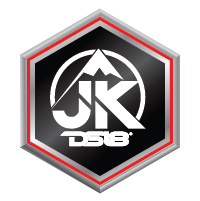
- Loudspeakers
- Accessories and Wires
- Batteries and Chargers
- Packages And Bundles
- View All Motorcycle
- Head Units And Streamers
- Accessories/Wires
- Package and Bundles
- View All Marine
- View All Powersports
- Harley Davidson
- All Packages
- Best Sellers
- New Arrivals
- Coaxials and Components
Your cart is empty
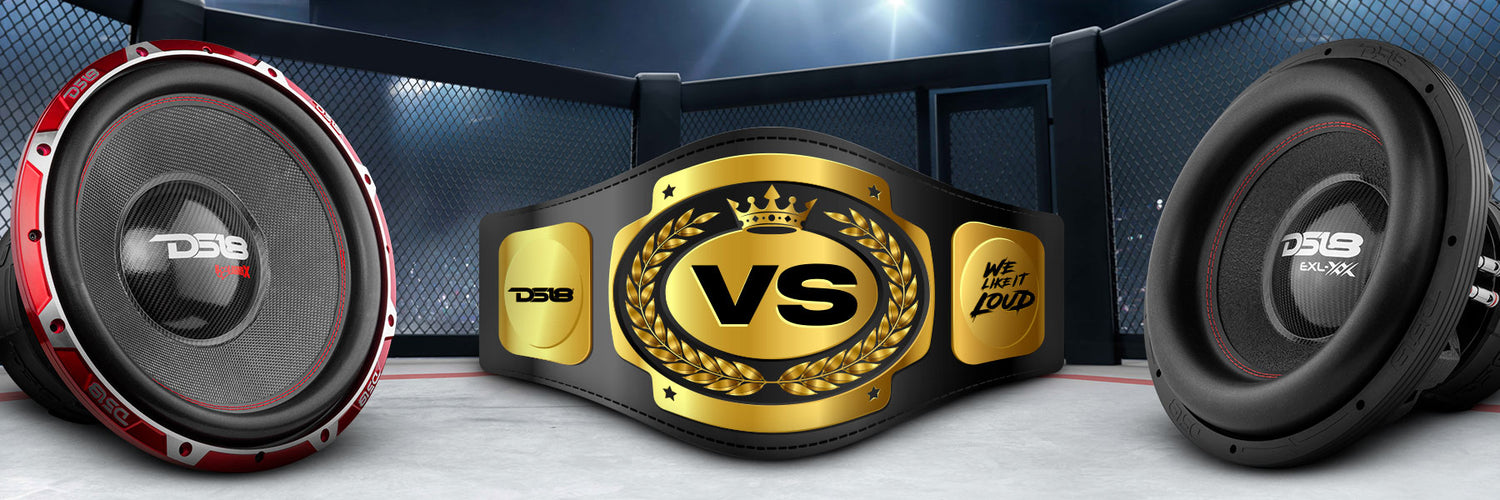
High Excursion Subwoofers vs. SPL Subwoofers
Subwoofer showdown: high excursion subwoofers vs. spl (sound pressure level) subwoofers.
If you like it LOUD, you know that no system is complete without a good subwoofer.
A good subwoofer can make or break your audio setup; and in the world of competitive audio there are two main types to consider - high excursion and SPL (Sound Pressure Level).
Let’s dissect the features of each and help you decide which one is best to make your system LOUD!

What is High Excursion?
High excursion subwoofers are for the enthusiasts who want bass that hits them right in the soul. The term "excursion" refers to the movement of the subwoofer cone, and a high excursion subwoofer is capable of moving a greater distance compared to its SPL counterpart. These bad boys move air like it owes them money, creating deep, bone-shaking bass. We're talking about subwoofers that can dance to a rhythm so low it makes your heart skip a beat.
Now, the beauty of high excursion subwoofers is in their precision. The increased cone movement ensures that even the most subtle nuances in the low-frequency range are faithfully reproduced, for an immersive experience that'll leave you breathless.
Now, let's talk strategy. Subs with higher excursion and lower FS naturally play lower, all really depending on how the box is tuned. High excursion subs, especially those with low FS, thrive on lower port tuning in ported boxes. Even in sealed boxes, they'll hit those lower notes, although not as low as the ported box: making customization, installation and placement a bit less of a hassle.
However, it's worth noting that high excursion subwoofers have a larger pole length, surround and spider landing to accommodate for the higher excursion and lower frequencies. These are not the subs for lightweights. Installing these mammoths might be a challenge, and they might demand a beastly amp to unleash their full potential.

Understanding SPL (Sound Pressure Level)
SPL subwoofers, on the other hand, are designed to maximize the volume output of your audio system. Sound Pressure Level refers to the intensity of sound waves and is measured in decibels (dB). An SPL subwoofer is engineered to produce incredibly high decibel levels, resulting in a louder and more impactful bass experience. It's all about making your system scream at the top of its lungs!
For those who crave the feeling of being at a live concert or want to impress their friends with earth-shattering bass, an SPL subwoofer is the way to go. These subwoofers excel at delivering bone-rattling bass that is sure to make an impression. They are often used in car audio competitions where the goal is to achieve the highest possible SPL reading.
But hold on, there's a trade-off. SPL subs might sacrifice a bit of accuracy for the sake of volume. Your bass might be more boom than precision. And, make no mistake, they demand power - your amp better be up for the challenge.

Which Subwoofer is Right for You?
High Excursion or SPL? It's a showdown. High Excursion gives you accuracy, precision, and an immersive experience. SPL delivers raw, bone-rattling power that'll make your ride the envy of the block.
When it comes to choosing between high excursion and SPL subwoofers, it ultimately depends on your personal preferences and listening habits.
If you prioritize accuracy, precision, and a more immersive listening experience, high excursion subwoofers are the way to go. On the other hand, if you crave maximum volume output and want to feel the bass in your core, SPL subwoofers will deliver.
Consider your setup - is it spacious or cramped? High excursion subs are like a muscle car - big and bold. SPL subs, while still demanding space, are more like a sleek sports car that packs a punch.
Don’t forget your amp - High excursion subwoofers require more power to achieve the same volume level as an SPL subwoofer, but offer a more accurate boom. Make sure your amplifier can handle the demands of your chosen subwoofer type to avoid any performance issues.
DS18’s Popular High Excursion Subwoofer Models
There are several popular high excursion subwoofer models on the market that are worth considering:
- GEN-XX15.4DHE : This 15” beast delivers unparalleled low-frequency performance without breaking the bank, bringing the heart-pounding sensation of concert-quality bass right into your car.
Shake the neighborhood and turn heads with a frequency response of 20Hz to 1KHz, offering a wide range of bass reproduction that lets you savor every detail of your favorite tracks.
- EXL-XX15.4DHE : Get ready to feel the thunder on the asphalt with a 15-inch High Excursion Car Subwoofer engineered for the true audio connoisseur.
What truly sets the EXL-XX15.4DHE apart is its high excursion surround, pushing the limits with an Xtraordinary 42mm Xmax. Every note resonates with accuracy and depth, for an immersive audio landscape that's as rich as it is powerful.
- HOOL-X15.4DHE : Meet the legend – the DS18 HOOL-X15.4DHE, also known as the "High Excursion Hooligan." This 15" High Excursion Car Subwoofer is not just a subwoofer; it's a force to be reckoned with, delivering 4000W RMS and 6000W MAX power to blow your audio expectations out of the water.
With a sensitivity of 88.3dB, an Xmax of 59 mm, and a frequency response ranging from 16Hz to 500Hz: every beat is reproduced with staggering depth and precision.
DS18’s Popular SPL Subwoofer Models
Ladies and gentlemen, brace yourselves for a legend that's been shaking streets and winning lanes for over six years – the DS18 HOOL-X15.4DSPL , a true HOOLIGAN in the world of SPL Car Subwoofers. We've taken this iconic line to new heights with the HOOLIGAN X15 Sound Pressure Level – it's the beast that roars louder, hits harder, and demands your attention.
At the heart of this beast is a high-powered 4" aluminum voice coil, capable of handling a staggering 4000W RMS and 6000W MAX power. Reinforced with a larger SPL surround, this version cranks up the capability to handle high SPL’s, playing louder and cleaner than any subwoofer that has come before.
Conclusion and Final Thoughts
In the ultimate showdown between high excursion and SPL subwoofers, there is no clear winner. The right choice depends on your personal preferences, listening habits, and the specific requirements of your audio setup. High excursion subwoofers offer accuracy, precision, and an immersive listening experience, while SPL subwoofers deliver maximum volume output and bone-rattling bass.
Consider factors such as sound preference, space requirements, amplifier compatibility, and budget when making your decision. And remember, there is no substitute for experiencing the subwoofers firsthand. Visit your local audio store to listen to different models and determine which one resonates with you the most.
Follow DS18 on TikTok , Instagram , and Facebook for more tips and tricks on Getting LOUD!
Continue reading

DS18 Supercharges Big5’s Jeep Audio System
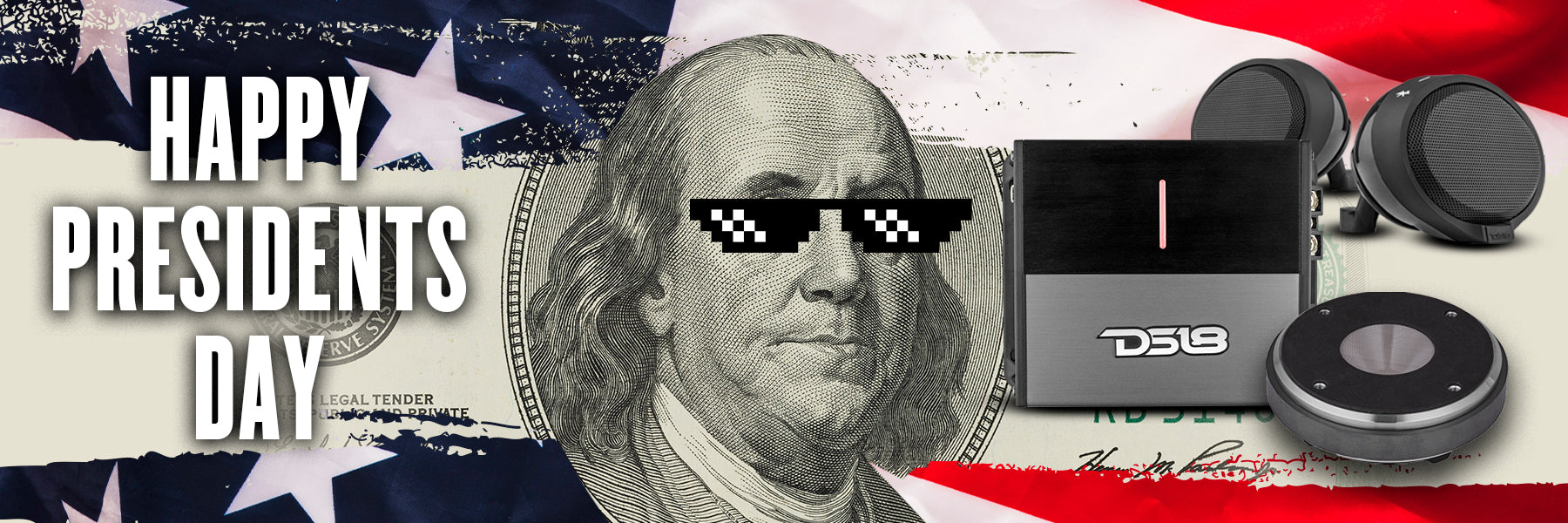
Preparing For President’s Day @ DS18
Leave a comment
All comments are moderated before being published.
This site is protected by reCAPTCHA and the Google Privacy Policy and Terms of Service apply.

We are loading your cart...
HomePod 2 vs HomePod: What's the difference and should you upgrade?
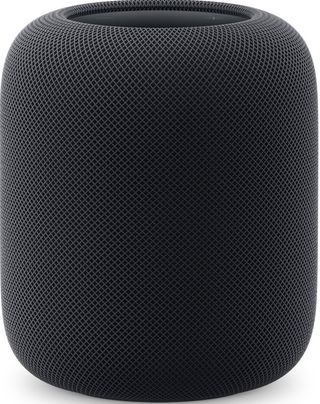
- Available in midnight (and white)
- Updated sensors
- Can't pair with older HomePods
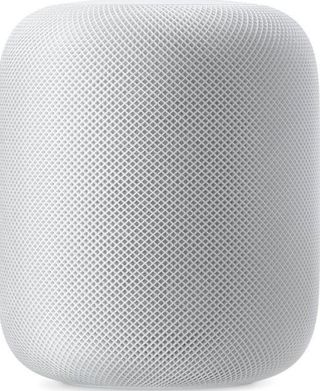
- Still makes beautiful music
- Can't stereo pair with other HomePod models
- Lacking new features
- Not readily available
- No midnight version
This first HomePod was released in 2018 and surprisingly retired three years later without a replacement. (No, the HomePod mini doesn't count.) Fast forward to early 2023, when Apple finally, at last, has announced the HomePod 2 . Featuring a fresh new design and internals, Apple's new 2nd-geneartion HomePod is available in white -- and midnight for the first time.
It isn't easy to find a new HomePod to purchase. Therefore, this comparison primarily focuses on the advances Apple has brought to the table with HomePod 2. As you'll see, the changes are substantial both in its design and feature set.
HomePod 2 vs HomePod: What are the differences?
It will take a full review to determine whether the HomePod 2 sounds better than the HomePod. It should, given its technical advances on the inside. We already know that the HomePod 2 packs many more features than the original. These include all-new sound recognition, sensors for temperature and humidity, support for the Matter smarthome standard , and more.
At the heart of the HomePod 2 is a "high excursion" woofer that Apple promises packs deep, rich bass. In addition, it offers a 20mm diaphragm with its bass EQ mic that is dynamically able to tune low frequencies in real-time.
As Apple exclaims: "Superclean bass. Fills the room. Boom."
To hit the high notes, the HomePod 2 includes an array of five beamforming tweeters around its base. Each tweeter is optimized at high frequencies to produce detailed, articulate audio with terrific clarity. Sound is even better thanks to advanced computational audio with system sensing, a four-microphone design for far-field Siri, and Spatial Audio with Dolby Atmos for music and video.
Like its predecessor, the HomePod 2 also includes stereo pairing. You'll need to do that with another HomePod 2, however: You can't stereo pair the HomePod 2 with an original HomePod or a HomePod mini.
Other impressive features include advanced computation audio with system sensing, multiroom audio with AirPlay, and advanced audio controls.
New on the HomePod 2 are two new sensors, one for sound recognition and the other for temperature and humidity. The former won't launch until a software update arrives later in the year. It's designed to detect smoke and carbon monoxide alarm sounds and send notifications. The other will keep track of indoor conditions.
HomePod 2 vs HomePod: Should you upgrade?
It remains to be seen whether current HomePod owners should upgrade to the HomePod 2. On the one hand, the newer model offers new features that almost certainly include better sound than produced on the older model. On the other hand, if you're a stereo user, plan to buy at least two new HomePods to get the job done since you can't pair old and new.
The new HomePod is certainly cheaper than the first generation model, which came out at $350 -- a lot of money for a speaker, even if it was an Apple designed smart speaker. The new one is $50 less, but where are these savings even coming from ?
The bottom line is that a future iMore review will tell us much more about the HomePod 2 than we know right now. Regardless, they all work with the best iPhones and other Apple devices.
The new HomePod
The Apple product we didn't know was coming, the HomePod 2 offers lots of new features and internals. It's available at the same great price as the original model when it was being sold by Apple.
Still powerful
The jury is still out on whether to replace your HomePod with the HomePod 2. This remains a great device and one that won't be forgotten soon.
Master your iPhone in minutes
iMore offers spot-on advice and guidance from our team of experts, with decades of Apple device experience to lean on. Learn more with iMore!

Bryan M. Wolfe has written about technology for over a decade on various websites, including TechRadar, AppAdvice, and many more. Before this, he worked in the technology field across different industries, including healthcare and education. He’s currently iMore’s lead on all things Mac and macOS, although he also loves covering iPhone, iPad, and Apple Watch. Bryan enjoys watching his favorite sports teams, traveling, and driving around his teenage daughter to her latest stage show, audition, or school event in his spare time. He also keeps busy walking his black and white cocker spaniel, Izzy, and trying new coffees and liquid grapes.
Apple's long-rumored 'HomePod with a screen' gets an update, but it's not coming anytime soon
HomePod with a built-in display leaked in tvOS 17.4 beta — is this the smart speaker update we've been waiting for?
The long-awaited iPad event may have a date, but it's not all good news
Most Popular
By James Bentley September 27, 2023
By Tammy Rogers September 27, 2023
By Tammy Rogers September 18, 2023
By Tammy Rogers September 14, 2023
By Tammy Rogers September 12, 2023
By Lloyd Coombes, Gerald Lynch August 07, 2023
By Matt Hanson May 22, 2023
By Palash Volvoikar April 13, 2023
- 2 Apple hasn't forgotten about the iPad Mini after all as insider reports that a new model is in development
- 3 Apple Watch mastermind could take iPhone’s AI to the next level
- 4 Apple just opened up the App Store to game emulators, but there's a catch
- 5 Another app subscription model switcheroo has users up in arms, and this time they probably have a reason to be annoyed

Selected Categories
- Loudspeakers
- Digital Sources
- Analog Sources
- Cables and Interconnects
- AC Power Products
- Accessories
View All Reviews

Featured Reviews
- 50 Greatest Bargains in High-End Audio
- Goldmund PH3.8 Nextgen Phonostage
- Wilson Audio Specialties Chronosonic XVX Loudspeaker, Subsonic Subwoofer, and ActivXO Crossover
- Schiit Audio Modius DAC and Magnius Preamplifier/Headphone Amplifier
- YG Acoustics Hailey 2.2 Loudspeaker
Selected Locations
- Canjam Global
- Capital Audiofest
- Rocky Mountain
View All Show Reports

Featured Show Reports
- Florida Audio Expo 2020
- The Warsaw Audio Video Show
- RMAF 2019 - Highlights and Photos
- Rocky Mountain Audio Fest 2019 : Loudspeaker
- Rocky Mountain Audio Fest 2019 : Digital Electronics
Featured Editors
- Alan Taffel
- Greg Cahill
- Matthew Clott
- Scott Markwell
- Stephan Scharf
- Stephen Estep
- Jeff Wilson
- Paul Seydor
- Jonathan Valin
- Robert Harley
View All Blogs

Featured Blogs
- Philosophical Notes: A New Audio Blog
- An Interview with John Bring of Cable Support Plate
- The Absolute Sound’s High-End Audio Hall of Fame | 2020 Inductees
- The Rune Grammofon Label
- Lauren Daigle’s Grammy Award Winning Album “Look Up Child” to be released December 11 in 45RPM LP Format
- Joan Osborne Has a Job to Do
- Best Products
- Back Issues
- Print Subscriber Services
- Digital Subscriber Services
Featured Music
- The Jayhawks: XOXO
- Christian Sands: Be Water
- Hank Williams: Pictures from Life’s Other Side
- Neil Young: Homegrown
- Elgar & Beach: Piano Quintets
View All Album Reviews
Featured genres.
- View All the Categories
- Martin Logan
- View All the Featured Brands

Begin typing your search above and press return to search. Press Esc to cancel.
Subwoofer Basics
- by Robert Harley
- Jul 15, 2015

Excerpted and adapted from The Complete Guide to High-End Audio (Fifth Edition). Copyright © 1994–2015 by Robert Harley. hifibooks.com . To order call (800) 841-4741.
Subwoofers are often misunderstood, both in name and in application. While they have a reputation for providing hefty bass lift, they need not be proverbial bulls in the china shop of your listening room. Although proper setup and integration require some attention and patience, the results can enhance the sound of a wide range of systems—without being “in-your-face” obvious about it. Put simply, it is possible to greatly improve a system’s performance by adding a subwoofer (or a pair of subs).
First, the basic definition: A subwoofer is a loudspeaker that produces low frequencies that augment and extend the bass output of a full-range loudspeaker system. The term subwoofer is grossly misused to describe any low-frequency driver system enclosed in a separate cabinet. But subwoofer actually means “below the woofer,” and the term should be reserved for those products that extend bass response to below 20Hz. A low-frequency driver in an enclosure with an output extending to 40Hz and used with small satellite speakers is more properly called a woofer.
You’ll also see full-range speakers with a built-in “subwoofer” powered by its own amplifier. Most of these products actually employ woofers that are simply driven by an integral power amplifier. Such a design relieves your main amplifier of the burden of driving the woofer, but the speakers must be plugged into an AC outlet.
Read on to find out about different types of subwoofers—and their pros and cons—as well as their setup, placement, and integration.
Active vs. Passive Subwoofers Subwoofers come in two varieties: passive and active. A passive subwoofer is just a woofer or woofers in an enclosure that must be driven by an external amplifier. In one variation of the passive subwoofer, the same stereo amplifier driving the main speakers also powers the subwoofer. In this least desirable method of connecting a subwoofer, the full-range output from a power amp is input to the subwoofer, and a crossover in the subwoofer removes low frequencies from the signal and outputs the filtered signal to the main loudspeakers. This technique puts an additional crossover in the signal path, to filter out bass from the speaker-level signals driving the main speakers. Some subwoofers are designed to extend the system’s bass response without filtering bass from the signal driving the main speakers. Although this technique doesn’t add a crossover to the signal path, it doesn’t increase the power handling of the main speakers, either. Keeping low bass out of your main speakers has many advantages, including a much cleaner midrange.
A better way of driving the passive subwoofer is with an electronic crossover and separate power amplifier. This method separates the bass from the signal driving the main loudspeakers at line level, which is much less harmful to the signal than speaker-level filtering. Moreover, adding a separate power amp for the subwoofer greatly increases the system’s dynamic range and frees the main-speaker amplifier from the burden of driving the sub. Adding a line-level crossover and power amp turns the passive subwoofer into an active subwoofer, and also makes the system bi-amplified.
A self-contained active subwoofer combines a subwoofer with a line-level crossover and power amplifier in one cabinet, eliminating the need for separate boxes and amplifiers. Such a subwoofer has line-level inputs (which are fed from the preamplifier), line-level outputs (which drive the power amp), and a volume control for the subwoofer level. The line-level output is filtered, removing low frequencies from the signal sent to the amplifiers driving the main loudspeakers. This crossover frequency is adjustable to allow you to select the frequency that provides the best integration with the main speakers. (I’ll write more about integration methods in subsequent sections.)
Subwoofer Pros and Cons Adding an actively powered subwoofer can greatly increase your system’s dynamic range, bass extension, midrange clarity, and ability to play louder without strain. The additional amplifier power and low-frequency driver allow the system to reproduce musical peaks at higher levels. Moreover, removing low frequencies from the signal driving the main loudspeakers lets them play louder because they don’t have to reproduce low frequencies. The midrange often becomes clearer because the woofer cone isn’t furiously moving back and forth, trying to reproduce low bass. This improvement in a small speaker’s performance can be dramatic. The small woofer’s excursion is no longer a limiting factor in how loudly the system will play when low frequencies are filtered from the signal driving it. The midrange is much cleaner, and the overall system sounds like a large, full-range speaker.
Now for the bad news: More often than not, subwoofers can degrade a playback system’s musical performance. Either the subwoofer is poorly engineered (many are), set up incorrectly, or, as is increasingly common, it’s designed to reproduce explosions in a home-theater system, not resolve musical subtleties.
Subwoofer Challenges (and Rewards) Let’s look at the theoretical problems of subwoofers. First, most subwoofers—passive or active—add electronics to the signal path. The active subwoofer’s internal crossover may not be of the highest quality. Even well-executed crossovers can still degrade the purity of very-high-quality source components, preamplifiers, and power amps. This drawback can be avoided by running the main loudspeakers full-range (no roll-off), but you then lose the dynamic advantages and additional midrange clarity conferred by keeping low frequencies out of the main speakers.
Second, the subwoofer’s bass quality may be poor. The subwoofer may move lots of air and provide deep extension, but a poorly designed subwoofer often adds a booming thumpiness to the low end. Rather than increase your ability to hear what’s going on in the bass, a subwoofer often obscures musical information.
Third, a subwoofer can fail to integrate musically with the main loudspeakers. Very low frequencies reproduced by the subwoofer can sound different from the midbass produced by the main speakers. The result is an extremely distracting discontinuity in the musical fabric. This discontinuity is manifested as a change in the sound of, for example, acoustic doublebass in different registers. Ascending and descending bass lines should flow past the crossover point with no perceptible change in timbre or dynamics.
Another factor that can make integrating a subwoofer difficult is matching a slow subwoofer to taut, lean, articulate main speakers. Put another way, the sound from an underdamped subwoofer won’t integrate very well with that from a pair of overdamped speakers.
Fourth, subwoofers often trade tight control, pitch resolution, and lack of overhang for greater sensitivity or deeper extension. This is particularly true of subwoofers designed for home theater. Consequently, many subwoofers sound bloated, “slow,” and lacking in detail.
Finally, a subwoofer can fill the listening room with lots of low-frequency energy, exciting room-resonance modes that may not have been that bothersome without the subwoofer. This problem of room-mode excitation can be ameliorated by using two (or more) subwoofers; each subwoofer will excite different room modes, substantially smoothing out the room’s low-frequency response. Placement is therefore crucial—you can’t put a subwoofer just anywhere and expect musical results.
All of these problems are exacerbated by the common tendency to set subwoofer levels way too high. The reasoning behind this is that if you’ve paid good money for something, you want to hear what it does. But if you’re aware of the subwoofer’s presence in the sound, either its level is set too high, or it isn’t positioned correctly, or it has been poorly designed. The highest compliment one can pay a subwoofer is that its contribution can’t be directly heard. It should blend seamlessly into the musical fabric, not call attention to itself.
Having said all that, my experience suggests that a subwoofer/satellite system can outperform a similarly priced, full-range loudspeaker system.
Here are some compelling reasons why:
- The satellite speakers can be positioned for the best soundstage without regard for how that position affects the bass response.
- The subwoofers can be positioned for the best bass integration in the room without regard for soundstaging.
- It is much more cost-effective to build a subwoofer enclosure than it is to build the large enclosure of a full-range loudspeaker (to accommodate large woofers), which may have expensive cabinet construction and wood or paint finishes. The subwoofer is less likely to be a prominent part of the home decor, and thus doesn’t require lavish finish quality.
- The subwoofer/satellite system gives you a large measure of control over the bass performance, including the amount of bass and how that bass integrates with the room. A full-range loudspeaker offers no such control.
However, I must add that I hold these things to be true with two big caveats: The first is that the subwoofer must be of exceptional quality and be designed for musical performance, not booming home-theater effects. Only a tiny handful of the hundreds of subwoofers on the market fall into this category. Second, achieving seamless integration between the subwoofer and satellites and realizing smooth bass response requires skill and patience. The subwoofer/satellite system is a better choice for someone who enjoys the technical side of audio rather than for the music lover who just wants good sound without having to ascend the learning curve.
The counterargument suggests that a loudspeaker system should be designed and engineered with a single vision, not with a piecemeal approach by different designers. (For more on this, see the Subwoofer Integration section below.)
Subwoofer Placement Tips Subwoofer placement also has a large effect on how much bass you hear and how well the sub integrates with your main speakers. When a subwoofer is correctly positioned, the bass will be clean, tight, quick, and punchy. A well-located subwoofer will also produce a seamless sound between the sub and the front speakers; you won’t hear the subwoofer as a separate source of sound. A poorly positioned subwoofer will sound boomy, excessively heavy and thick, lacking detail, and slow, with little dynamic impact. In addition, you’ll hear exactly where the front speakers leave off and the subwoofer takes over.
Here are some general guidelines for subwoofer placement. As with full-range speakers, avoid putting the sub the same distance from two walls. For example, if you have a 20′-wide room, don’t put the subwoofer 10′ from each wall. Similarly, don’t put the subwoofer near a corner and equidistant from the side and front walls. Instead, stagger the distances to the walls. Staggering the subwoofer’s distance from each wall smoothes the bass because the frequencies being reinforced by the wall are randomized rather than coincident.
You can also get more dynamic impact and clarity from your subwoofer by placing it close to the listening position. Sitting near the subwoofer causes you to hear more of the sub’s direct sound and less of the sound that has been reflected around the room. You hear—and feel—more of the low-frequency wavelaunch, which adds to visceral impact.
The simplest, most effective way of positioning a subwoofer is to temporarily put it as close to the listening position as feasible. Raise the subwoofer off the floor, if possible, so that it’s close to where the listeners’ ears will normally be. Play a piece of music with an ascending and descending bass line, such as a “walking” bass in straight-ahead jazz. Crawl around the floor on your hands and knees (make sure the neighbors aren’t watching) until you find the spot where the bass sounds smoothest, and where each bass note has about the same volume and clarity. Avoid positions where some notes last longer, and/or sound slower or thicker, than others. When you’ve determined where the bass sounds best, put the subwoofer there permanently. Now, when you’re back in the listening seat, the bass should sound smooth and natural.
Subwoofer Integration Tricks It’s relatively easy to put a subwoofer into your system and hear more bass. What’s difficult is making the subwoofer’s bass integrate with the sound of your main speakers. Low bass as reproduced by a subwoofer’s big cone(s) can sound different from the bass reproduced by the smaller cones in the left and right speakers. A well-integrated subwoofer produces a seamless sound, no boomy thump, and natural timbre. A poorly integrated sub-woofer will sound thick, heavy, boomy, and unnatural, calling attention to the fact that you have smaller speakers reproducing the frequency spectrum from the lower midrange up, and a big subwoofer putting out low bass.
Integrating a subwoofer into your system is challenging because the subwoofer is optimized for putting out lots of low bass, not for reproducing detail. The main speakers’ upper bass is quick, clean, and articulate. The subwoofer’s bass is often slow and heavy. The word “slow” in this application is not technically correct, but vividly describes how such a subwoofer sounds. More precisely, a “slow” subwoofer is one that has excessive overhang: the cone keeps moving long after the drive signal has stopped, which conveys the impression that the bass is “slow.”
Achieving good integration between small speakers and a subwoofer is easier if you buy a complete system made by one manufacturer. Such systems are engineered to work together to provide a smooth transition between the sub and the main speakers. Specifically, the crossover network removes bass from the left and right speakers, and removes midrange and treble frequencies from the signal driving the subwoofer. If all these details are handled by the same designer, you’re much more likely to get a smooth transition than if the subwoofer is an add-on component from a different manufacturer.
If you do choose a subwoofer made by a different manufacturer, several controls found on most subwoofers help you integrate the sub into your system. One control lets you adjust the crossover frequency—the frequency at which the transition between the subwoofer and the main speakers takes place. Frequencies below the crossover point are reproduced by the subwoofer; frequencies above the crossover point are reproduced by the main speakers. If you have small speakers that don’t go very low in the bass and you set the crossover frequency too low, you’ll get a “hole” in the frequency response. That is, there will be a narrow band of frequencies that aren’t reproduced by the woofer or the main speakers.
Setting the subwoofer’s crossover frequency too high also results in poor integration, but for a different reason. The big cone of a subwoofer is specially designed to reproduce low bass. When it is asked to also reproduce upper-bass frequencies, those upper-bass frequencies are less clear and distinct than if they were reproduced by the smaller main speakers. Finding just the right crossover frequency is the first step in achieving good integration. Most subwoofer owner’s manuals include instructions for setting the crossover frequency. As a rule of thumb, the lower the subwoofer’s crossover is set, the better.
Some subwoofers also provide a knob or switch marked “phase.” Phase essentially is a time difference between two soundwaves. To understand a subwoofer’s phase control, visualize a soundwave being launched from your subwoofer and from your main speakers at the same time. Unless the main speakers and subwoofer are identical distances from your ears, those two soundwaves will arrive at your ears at different times; that is, they will have a phase shift between them. In addition, the electronics inside a subwoofer can create a phase shift in the signal. The sub’s phase control lets you delay the wave generated by the subwoofer so that the subwoofer’s wave is perfectly in-sync with the wave from the main speaker. When the soundwaves are in phase, you hear a more coherent and better-integrated sound. One way of setting the phase control is to sit in the listening position with music playing through the system. Have a friend rotate the phase control (or flip the phase switch) until the bass sounds the smoothest.
But there’s a much more precise way of setting the phase control that guarantees perfect phase alignment between the subwoofer and main speakers. First, reverse the connections on your main loudspeakers so that the black speaker wire goes to the speaker’s red terminal, and the red speaker wire goes to the speaker’s black terminal. Do this with both speakers. Now, from a test CD or device app that offers pure test tones, select the track whose frequency is the same as the subwoofer’s crossover frequency. Sit in the listening position and have a friend rotate the subwoofer’s phase control until you hear the least amount of bass. The subwoofer’s phase control is now set perfectly. Return your speaker connections to their previous (correct) positions: red to red, black to black.
Here’s what’s happening when you follow this procedure: By reversing the polarity of the main speakers, you’re putting them out of phase with the subwoofer. When you play a test signal whose frequency is the same as the subwoofer’s crossover point, both the sub and the main speakers will be reproducing that frequency. You’ll hear minimum bass when the waves from the main speakers and subwoofers are maximally out of phase. That is, when the main speakers’ cones are moving in, the subwoofer’s cone is moving out. The two out-of-phase waves cancel each other, producing very little bass. Now, when you return your main speakers to their proper connection (putting them back in phase with the subwoofer), they will be maximally in-phase with the sub. This is the most accurate way to set a subwoofer’s phase control, because it’s easier to hear and identify the point of maximum cancellation than the point of maximum reinforcement. Unless you later move the subwoofer or main speakers, you need to perform this exercise only once.
A useful modern subwoofer feature is an automatic equalization circuit that measures the frequency response of your system in your room and tailors the subwoofer’s output to provide flatter response. You connect a supplied calibration microphone to the subwoofer, push a button, and the subwoofer emits a series of tones that are picked up by the microphone and analyzed by a circuit in the subwoofer. The subwoofer then equalizes its output, applying a boost to certain frequencies and a cut to others so that the resultant output is as flat as possible.
It’s worth noting that the best integration results from adding two (or more) subwoofers to your system. Two subwoofers drive the air in the room more uniformly, with fewer standing waves. The result is smoother bass throughout the room, and better integration with the main speakers.
Adapted from The Complete Guide to High-End Audio (Fifth Edition). Copyright©1994–2015 by Robert Harley. hifibooks.com . To order call (800) 841-4741.
Latest Videos
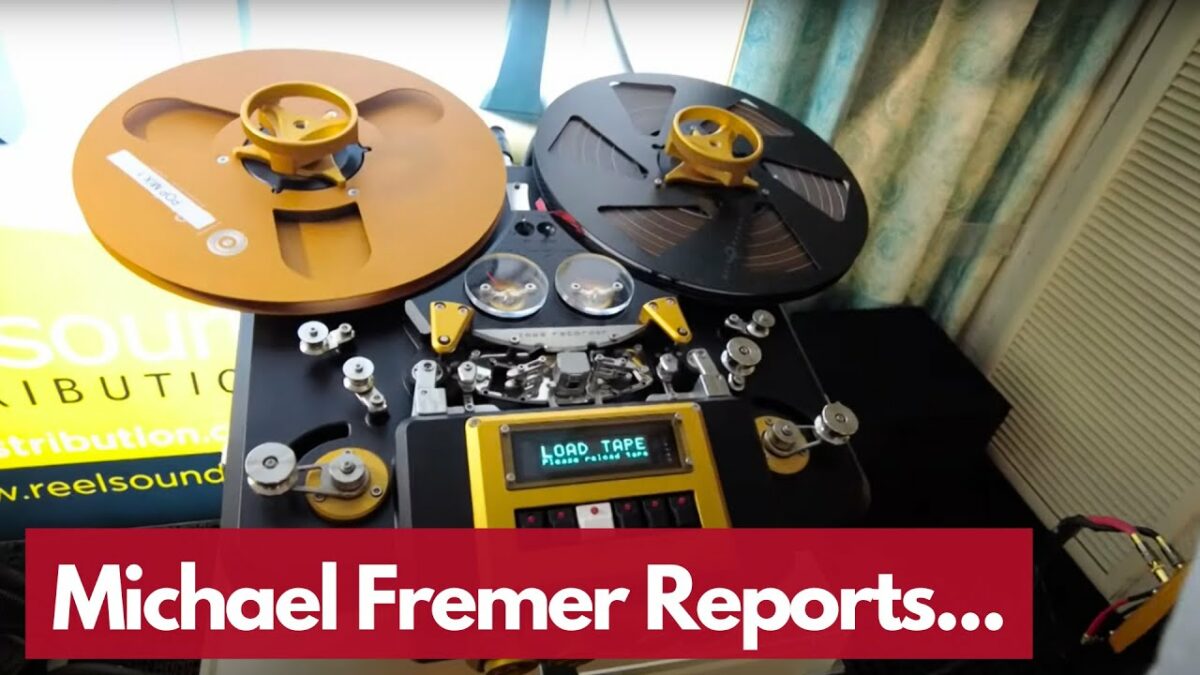
Full Fremer at Florida | FLIAX 2024

Schiit Tyr MonoBlock Amplifiers Review | Thomas Tan Reports
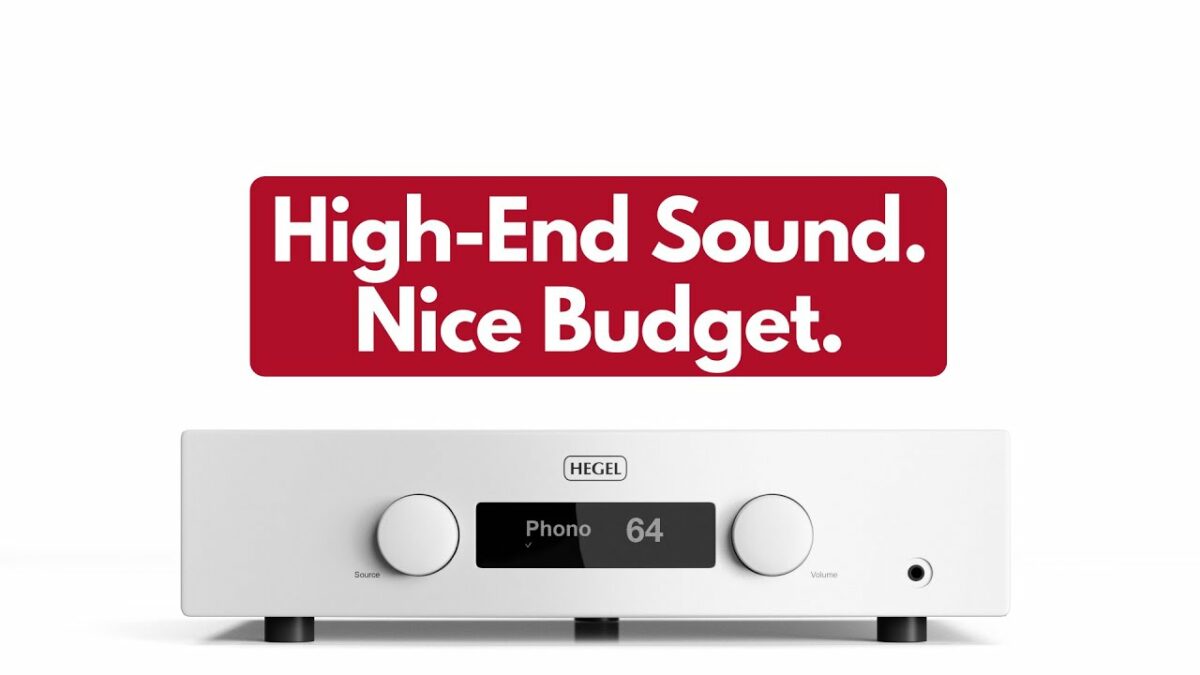
Hegel 190v Integrated Streaming Amplifier Review | Tom Martin Reports

PS Audio StellarGold DAC Review | Adrian Alexander Reports

By Robert Harley
My older brother Stephen introduced me to music when I was about 12 years old. Stephen was a prodigious musical talent (he went on to get a degree in Composition) who generously shared his records and passion for music with his little brother.

Read Previous
Dealer event at audio advice north carolina.

Avantgarde Acoustics Trio/Basshorn Loudspeaker System
Read next from blog.

Magnepan’s NEW “Speaker” Range..? | Tom Martin Previews
- Apr 09, 2024

Going Spatial
- Apr 06, 2024

Vinyl Break-In?
- Mar 29, 2024

Selling My Records
- Mar 26, 2024
Adblocker Detected
"Neque porro quisquam est qui dolorem ipsum quia dolor sit amet, consectetur, adipisci velit..."
"There is no one who loves pain itself, who seeks after it and wants to have it, simply because it is pain..."

What Subwoofer Has the Most Excursion? [REVEALED]

The Dayton Audio HTS545HE-4 21 is a subwoofer that has a lot of excursion. This subwoofer can move a lot of air, which is why it is able to create a lot of bass. The HTS545HE-4 21 also has a large woofer, which helps it to move more air.
This subwoofer is perfect for people who want to create a lot of bass in their music. A good subwoofer can make or break your sound system. So, what is the best subwoofer for you?
What is Excursion?
Excursion is the ability of a speaker to move in and out of its enclosure. This is important because it affects how loud the speaker can play without distortion.
A subwoofer with a lot of excursion will be able to play loudly without distortion , which is great if you want to feel like you’re shaking the house. However, some people might find this type of subwoofer too loud or disruptive.
So, what is the best subwoofer for you depends on your preferences and needs. But, one thing is for sure: a good subwoofer will have plenty of excursion!
How Do Excursion works in Subwoofers?
Excursion is the distance a driver or speaker can move from its rest position before it begins to produce sound.
This is important because, as the speaker moves away from its rest position, it increases the amplitude (volume) of low-frequency tones that are produced.
In fact, excursion is such an important factor in subwoofer design that manufacturers often use it to differentiate their products.
There are a few factors that determine how much excursion a subwoofer can muster. The first is speaker size and shape.
Larger speakers tend to have more excursion than smaller speakers, and round speakers tend to have more excursion than rectangular speakers. Second, the type of driver used in the subwoofer also plays a role.
Most subwoofers use cone drivers, which have greater excursion than magnet drivers.
Finally, woofer material affects excursion as well. Woofers made from paper or other thin materials typically have less excursion than woofers made from heavy materials like metal or plastic sheets.
Which Subwoofer Has the Most Excursion?

The HTS545HE-4 21″ Kraken High Excursion Subwoofer cranks out low-end bass like nothing else, thanks to its 6.5″ voice coil, 5″ diameter, and 31″ excursion.
The 4 ohm impedance works well with amplifiers, but be careful to monitor its amplifier and volume levels.
This subwoofer is rated for 300W of power, but if you’re running it at high volume, be sure to monitor its temperature. Also, if you listen to music with lower frequencies, such as EDM or hip-hop, this subwoofer may be overkill. The HTS545HE-4 is backed by Dayton Audio’s Best In Show® warranty, which means that this subwoofer is covered by a 1-year limited warranty for parts and labor.
How We Pick & Test?
Panel testing: We test subwoofers with an expert listening panel, and we conceal the identities of the subwoofers to eliminate bias. Scientific testing: We conduct CTA-2010 output measurements of all subwoofers to obtain an objective comparison of their capabilities. Size matters: Big subwoofers tend to sound better and play louder, but they take up a lot of space. We’ve included picks of all sizes. Price range: We limited our testing to subwoofers in the $300 to $800 price range to keep the number of competitors manageable.
There are many subwoofers on the market with different capabilities and prices. It can be hard to decide which subwoofer has the most excursion to give you the best sound quality .
The main factor you should consider when purchasing a subwoofer is its wattage. The more watts it has, the louder it can play. However, other factors, like its size and excursion, are also important.
The size of a subwoofer affects how much space it takes up in your room and its ability to produce deep bass sounds.
The excursion of a subwoofer measures how much displacement it can produce when struck by an acoustic waveform. This determines how deep into your room it can go and what range of frequencies it can reproduce accurately.
What Is the Difference Between a 12-Inch and 15-Inch Subwoofer?
There are a few key differences between a 12-inch and 15-inch subwoofer. The 12-inch model has a shorter woofer cone, which allows for more excursion, or displacement of the driver unit.
This means that the speaker can move more air in response to your music, providing a deeper sound.
The 15-inch model has a longer woofer cone, which allows for less excursion, but also produces higher frequencies with greater clarity. So if you’re looking for a louder and bassier experience, the 15-inch model may be better for you.
How Much Should I Spend on a Subwoofer for best Excursion?
There are many factors to consider when purchasing a subwoofer, including the size of the room, the type of music you listen to, and your budget.
However, one factor that is often overlooked is the speaker’s excursion. This term refers to how much distance the speaker can travel before distortion sets in.
Generally speaking, a subwoofer with more excursion will be able to generate more bass than one with less excursion. This means that it can reach lower frequencies deeper into a room and create an overall fuller sound.
However, it’s important to consider your specific needs when shopping for a subwoofer – not all models with more excursion will be suitable for all rooms.
Additionally, it’s important to keep in mind that not all budget-friendly subwoofers are necessarily low in quality.
In fact, some of the best performers on the market cost less than $100. So don’t be afraid to try out different models until you find one that sounds great!
So, there you have it – The Dayton Audio HTS545HE-4 21 has the most excursion of any subwoofer on the market. It is incredibly powerful and can handle even the most extreme bass demands. If you are looking for an incredibly powerful subwoofer that can handle anything you throw at it, then the Dayton Audio HTS545HE-4 21 is the perfect choice.
Leave a Comment Cancel reply
Save my name, email, and website in this browser for the next time I comment.
- Architectural
- Indoor / Outdoor
- Center Channel
- Floor Standing
- Speaker Systems
- Home Subwoofers
- Bluetooth Speakers
- Amplifier Boards & Modules
- Home Audio Amplifiers
- Commercial 70V Amplifiers
- Multi-Zone Amplifiers
- Subwoofer Amplifiers
- Bass Shakers
- Compression Drivers
- Exciters & Tactile Transducers
- Full-range Drivers
- Horns & Waveguides
- Midrange Drivers
- Mini Speakers
- Passive Radiators
- Planar / Ribbon Transducers
- Pro Audio Drivers
- Replacement Diaphragms
- Speaker & Subwoofer Kits
- Speaker Cabinets & Accessories
- Computer-Based Measurement
- Measurement Microphones
- Test Tracks
- Audio Analyzers
- Audio Accessories
- Bluetooth Audio Adapters
- Digital Signal Processing
- Installation Accessories
- Speaker Stands
- View Cart ( 0 )
- View Wishlist ( 0 )

HTS545HE-4 Kraken 21" High Excursion Subwoofer with 5" Voice Coil 4 Ohm
Quick overview, product highlights.
- Massive 5" inside/outside wound voice coil for extreme power handling and incredible control
- 21 mm of excursion with minimal loss of motor force allows incredible displacement capability
- True dual spider design with ample spacing to keep excursion linear with low distortion
- Reinforced treated paper cone keeps unwanted resonances under control
- Aluminum shorting sleeve for minimal distortion when driven to extreme levels
- Unique over-excursion protection system warns you just before catastrophic failure
Product Manuals / Spec Sheets / Downloads
Buying options, product description.
It takes a monster to deliver serious bass response
You need to move a lot of air for high SPL and deep bass response, and Dayton Audio's HTS545HE-4 21" Kraken home theater subwoofer driver can beat most high output subwoofers in the industry. This massive driver is capable of 21 mm of excursion in each direction (@ 70% BL, Klippel verified) giving it the ability to move over 7 liters of displacement with each stroke. Displacement isn't all you need for maximum output; power handling and efficiency are also necessary. Capable of handling 2,000 watts RMS and with over 95dB sensitivity, the HTS545HE-4 has what it takes to deliver ultra-low frequency response with authority. Dayton Audio has released the Kraken to bring you true high output, low frequency bliss.
Know when to say when with Over-Excursion Protection
Although the Dayton Audio HTS545HE-4 21" is designed to produce incredibly low frequencies at phenomenal output for extended periods of time, we understand that subwoofers are frequently driven up to and beyond their published limits and we expect that this driver will be no exception. All too often subwoofers fail prematurely due to being over driven, so to minimize this from happening and to extend its life Dayton Audio implemented an OEP (Over-Excursion Protection) system which audibly alerts the user just before catastrophic failure occurs. The Dayton Audio's HTS545HE-4 is purposely built to provide years of the powerful bass you crave.
Extreme power, but also control and accuracy
Powering the Dayton Audio HTS545HE-4 is an advanced high energy double stacked ferrite motor assembly. Unlike neodymium magnets, the powerful ferrite magnets are capable of delivering a constant motor force even when exposed to high heat to keep power compression at a minimum. Its 5" inside/outside wound voice coil uses a fiberglass former that can withstand extreme temperatures to handle up to 2,000 watts RMS without issue. A large pole piece vent, 6 peripheral gap vents, and numerous vents between the frame and top plate allow plenty of air to move across the voice coil, further reducing power compression caused by increased resistance due to heat. To keep distortion to a minimum at high output, the pole piece also includes a large aluminum shorting sleeve. All of this gives the HTS545HE-4 the ability to deliver predictable and consistent low frequency output even when driven to extreme SPL levels for extended periods. In addition, most high excursion subwoofer drivers suffer from lower midbass response and tend to lack impact and punch, the HTS545HE-4 has the motor strength to produce unbelievable midband efficiency, control, and output which eliminates the need for additional midbass systems in large home theaters.
Built to last a lifetime
Dayton Audio built the HTS545HE-4 to take the continuous output necessary to accurately reproduce today's demanding movie soundtracks. The naturally damped treated paper cone is optimized and reinforced to handle the stress of exceptionally high excursion while maintaining its shape. To keep the cone under control, the HTS545HE-4 uses dual large diameter spiders with ample spacing to provide extreme linearity. A huge SBR foam surround is double stitched to the cone to allow for incredible linear excursion, even when driven to its limits and beyond. Holding everything together is a rugged cast aluminum frame that will not restrict airflow, and includes integrated push button wire terminals for a reliable and secure electrical connection. The HTS545HE-4 has been built to deliver years of worry-free performance.
Beware the power and impact of the Kraken
If you're looking for one of the highest output ultra-low frequency drivers in the industry, the Dayton Audio HTS545HE-4 is an unbeatable value. This versatile driver is a great choice for vented designs, back loaded horns, and even tapped horns. With a 4 ohm voice coil this driver is also perfect for use in dual and quad driver systems for the ultimate in extended low frequency output capability. A true monster of a driver, Dayton Audio's Kraken comes from the abyss to take you down into the depths.
Note: Please be sure to secure everything in your house before you release the Kraken.
OPTIMUM CABINET SIZE *
Sealed Volume 1.5 ft.³ Sealed F3 68 Hz Vented Volume 6 ft.³ Vented F3 29 Hz * Enclosure volume/F3s based on BassBox "optimum" calculations
Product Details
- Customer Service
- Where to Buy
- Warranty Registration
- News and Reviews
- Privacy Policy
- Order Tracking
- Your Account

705 Pleasant Valley Dr. Springboro, OH 45066
Accessibility Statement
937-743-8248
Cookie Consent
This website uses cookies or similar technologies, to enhance your browsing experience and provide personalized recommendations. By continuing to use our website, you agree to our Privacy Policy
© 2023 Dayton Audio. All Rights Reserved.
Shopping Cart: 0 Items
Your wishlist: 0 items.
All products featured are independently chosen by us. However, SoundGuys may receive a commission on orders placed through its retail links. See our ethics statement.
What is a subwoofer, and do you need one?
Published on May 12, 2023
So you’ve set up your sought-after soundbar or speaker system, but when you play your tunes, there’s something missing. Where’s the low bass? If you’re looking for that heart-pounding oomph from your home audio setup, you’ll need a subwoofer. Most setups can benefit from a good subwoofer, but both hi-fi novices and experienced audiophiles often overlook them. Let’s look at what’s involved in making your 2-channel system into a 2.1, or adding that .1 to any other configuration.
Music or movie aficionados looking for better bass performance from their home audio setup should get a subwoofer. With a sub, you’ll get more of the low bass frequencies than conventional loudspeakers or soundbars can deliver.
How do subwoofers work?
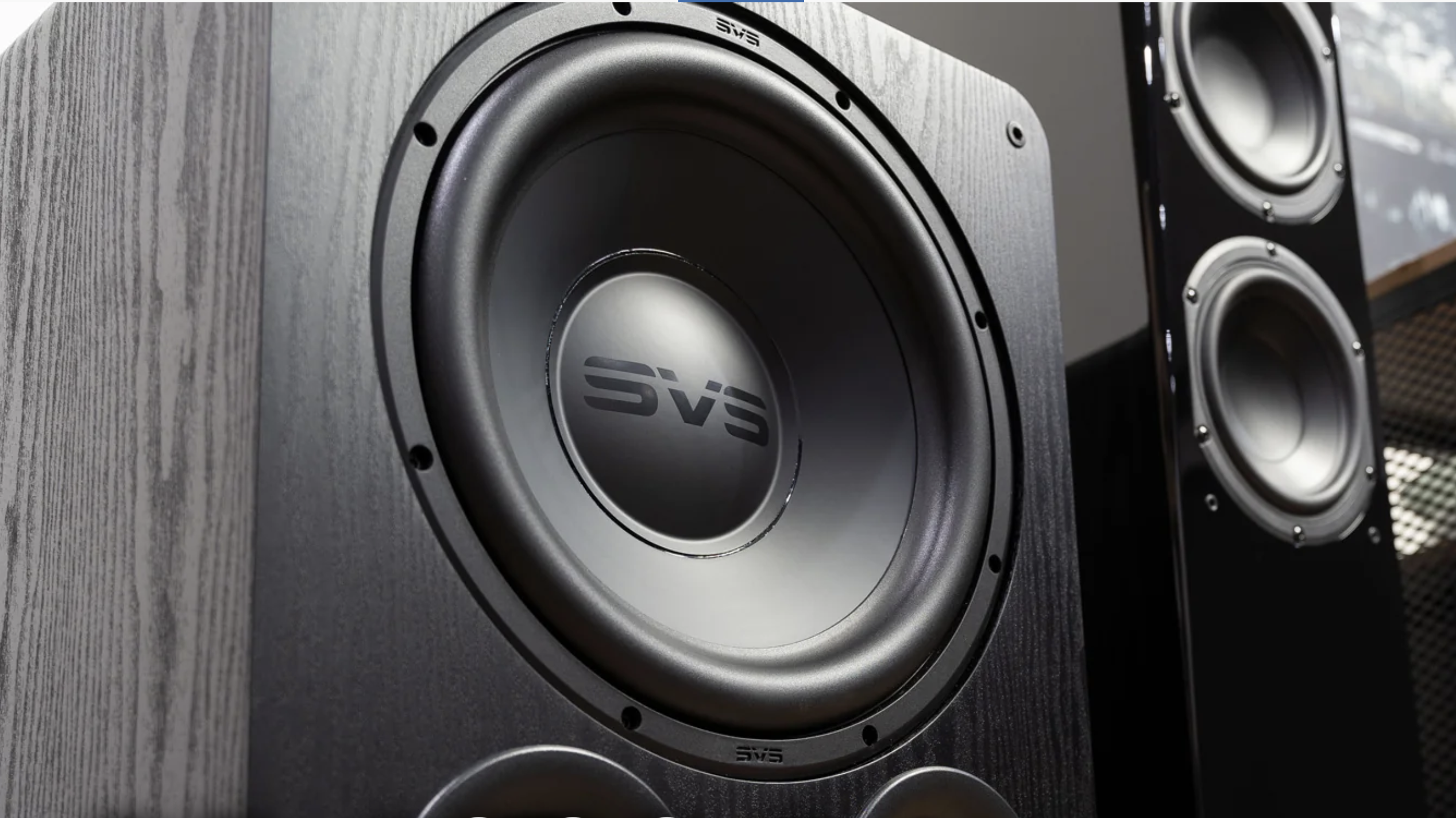
A subwoofer is a type of loudspeaker designed specifically to reproduce low frequencies. Conventional, full-range speakers try to cover as much of the frequency range as possible, up to (or beyond) 20kHz, but a subwoofer is intended to fill in the difficult-to-reproduce bass region up to around 80-150Hz. In this way, subwoofers complement an audio system composed of mains and/or satellite speakers by doing the heavy lifting involved in extending the bass response down to the lowest register.
Subwoofers work the same way as typical loudspeakers but are highly optimized to produce just those low frequencies. Moving coil loudspeaker drivers convert electrical signals from the source into sound waves you can hear (and feel). These drivers (or “woofers”) need to be large and come in standard sizes, which are typically 8, 10, 12, 15, or 16 inches in diameter. You may find multiple woofers mounted in the enclosure (aka cabinet), which is generally made from medium-density fiberboard, plywood, or other stiff, non-resonant materials.
The driver(s) and the enclosure combine to create an acoustic system, and different alignments can be used here. When the cabinet around the driver is sealed (what’s known as acoustic suspension), it creates an air cushion within the enclosure, which acts like a spring that the woofer’s diaphragm pushes and pulls against as it moves. This produces relatively low distortion and good phase linearity but requires a large cabinet, generally speaking.
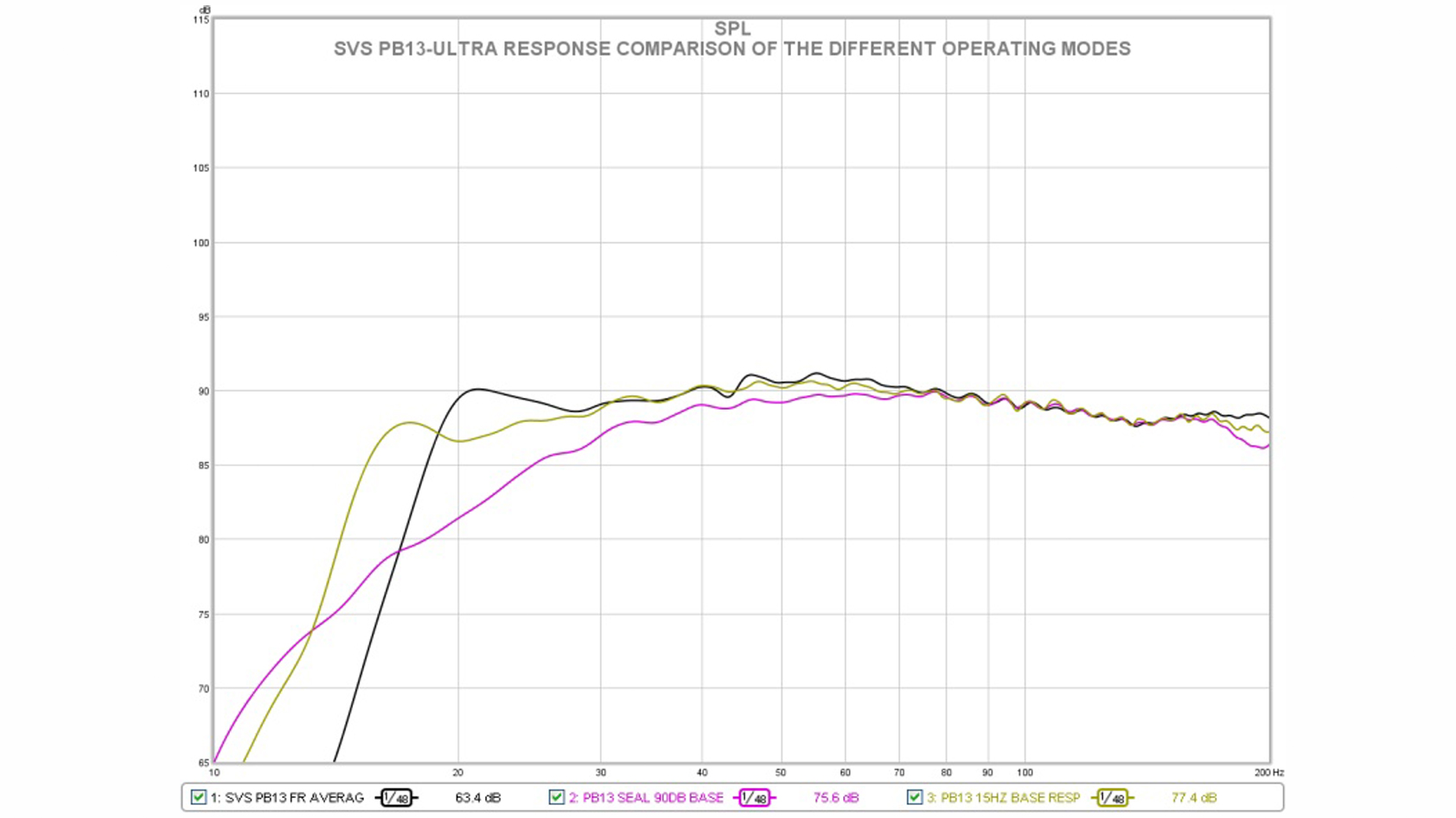
Conversely, most subwoofers employ a bass reflex system , where the enclosure is ported using a tube that looks like a circular hole or slot from the outside. The size of the port is tuned to create an acoustic resonance and will be optimized to give the best low end response for the driver and the size of the enclosure. This alignment extends the speaker’s usable bass response lower in frequency than sealed enclosures, but it rolls off much faster below resonance. The chart above compares the output of an SVS PB-13 Ultra subwoofer in sealed and ported operating modes.
Filters and crossovers
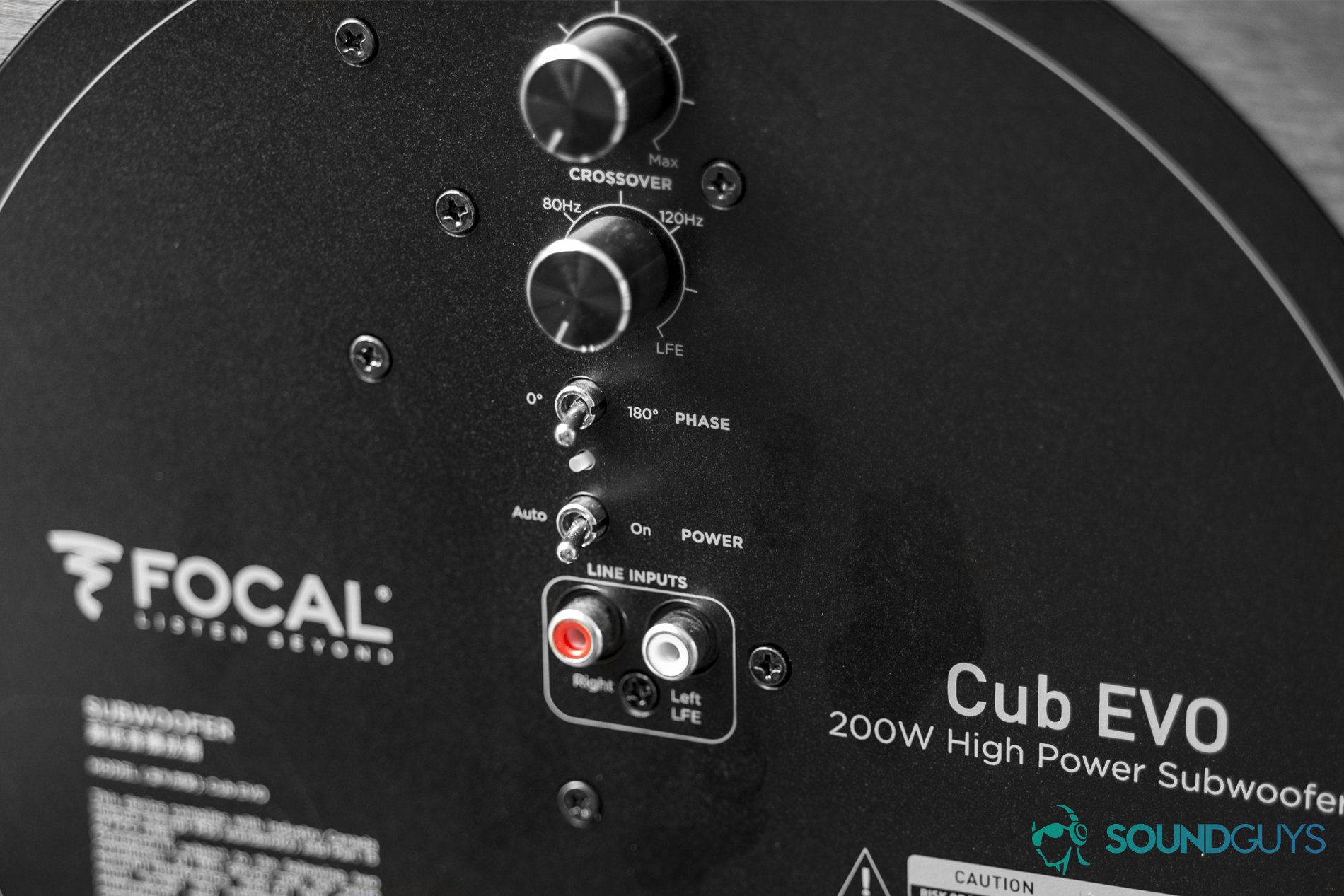
Because subwoofers are only intended to produce bass, the high-frequency content needs to be removed from the signal being fed to the driver. This is accomplished using a low pass filter . Adding on to this, the signal being fed to your main speakers can also be high passed , so each speaker is only being fed the signal it is best equipped to deal with. Low pass and high pass functions are combined in an electronic (active) crossover . Your receiver can handle these functions, or they may be built into the subwoofer itself.
Once the subwoofer is incorporated into the rest of your home audio setup (see below), experiment with the crossover dial. Most subwoofers have this dial on the back, determining the frequency that your subwoofer drops off in volume to acoustically blend in with the other speakers. If you know what the lowest frequency is that your main speakers can handle, you could start by setting it to that frequency.
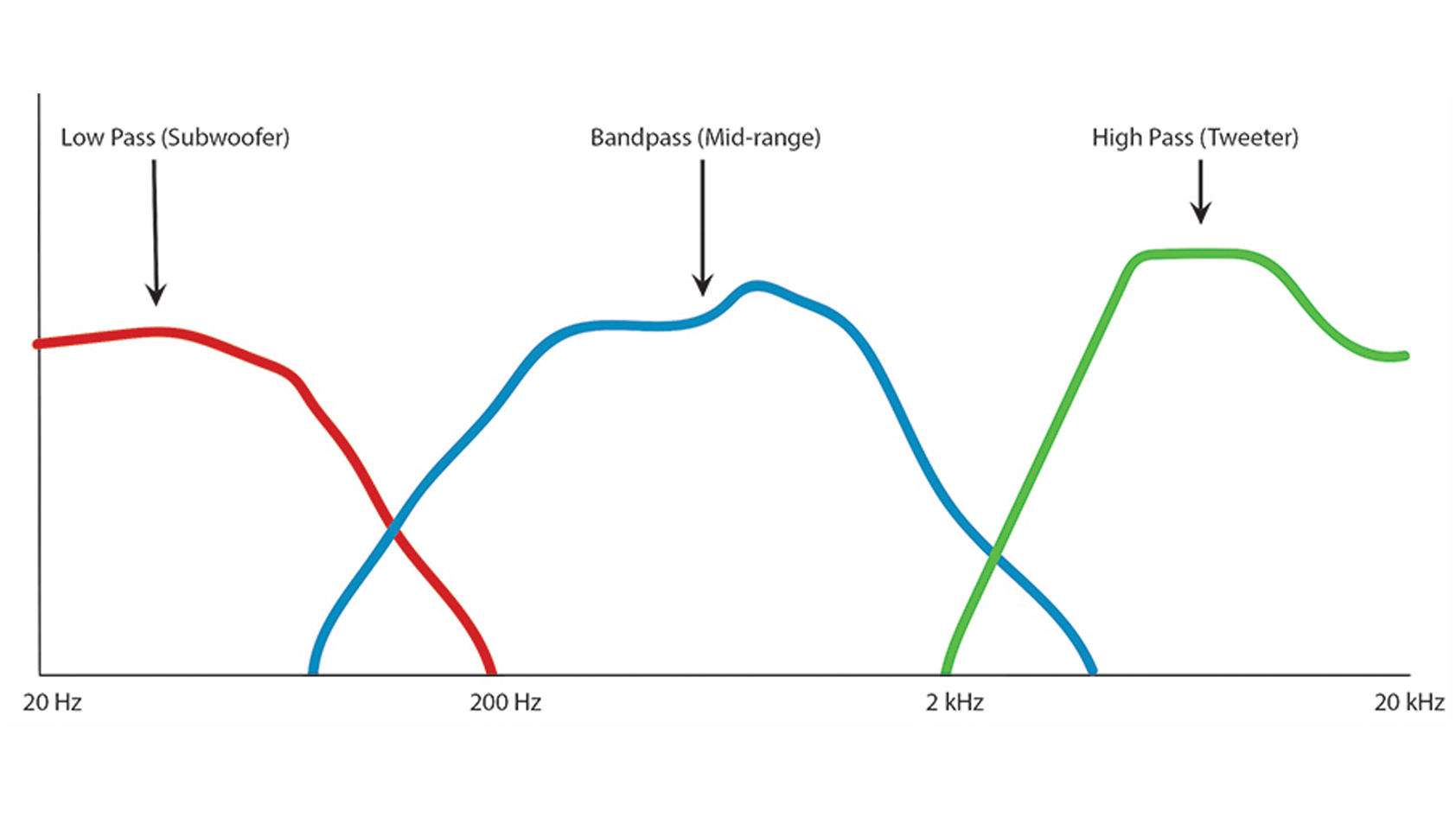
You may need to rope in a friend in to set the crossover frequency while you sit in the primary listening position and determine the best settings. If the bass seems too loud or too quiet relative to the main and satellite speakers, you may need to adjust the volume of your sub too. Some higher priced products allow you to do this yourself from the listening position using a remote control or smartphone app.

What’s the difference between passive and active subwoofers?
Like passive loudspeakers , a passive subwoofer requires external amplification. Because they tend to be less efficient, subwoofers require more power than typical speakers, so you need to make sure that your chosen amplifier can deliver enough power to get sufficient level from the subwoofer without running into clipping (distortion). If you’re not using a preamplifier or receiver with a dedicated “sub out,” you will also need some form of bass management to filter the bass component from the other (left, right, surround) audio channels.
Active (powered) subwoofers are far more common, have an integrated amplifier, and will handle the low pass filtering to ensure the subwoofer only receives the bass component of the signal. Everything is self-contained, and you shouldn’t need to purchase any extra hardware to get active subs running.
Where should you put a subwoofer for the best sound?
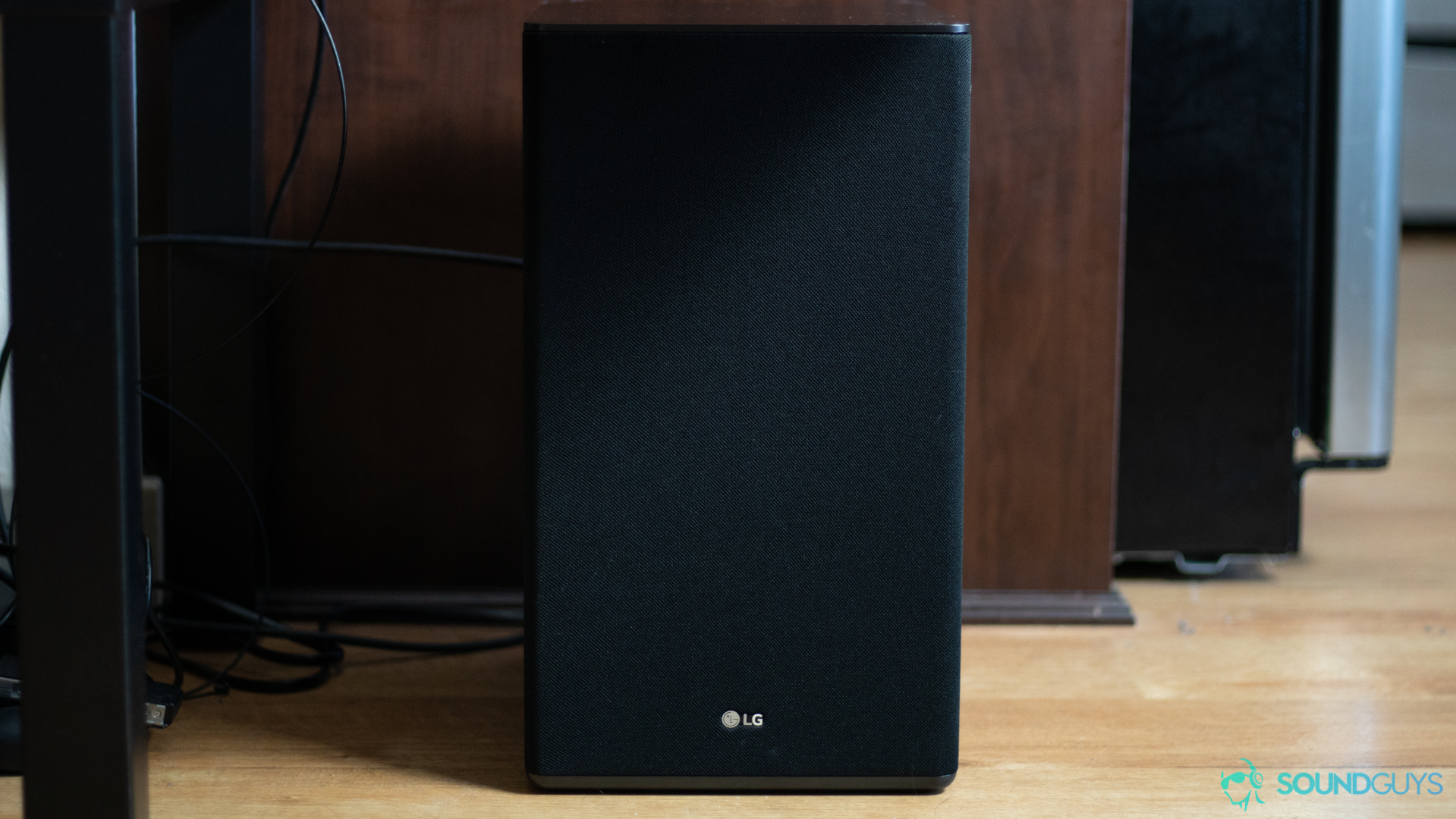
Placement of a subwoofer in your room requires special consideration. The first thing to be aware of is that we can’t localize sound sources below 100Hz. This is why we can use a single subwoofer for stereo or surround sound, since it doesn’t provide any directional information. So as long as your subwoofer’s low pass filter (crossover) is set below 100Hz, you can put it anywhere in the room and it will still work with your main speakers without drawing attention to itself. If your filter is set higher than that, then ideally your subwoofer should be placed in between the left and right main speakers.
If you want to hone in on the optimal location, and you’re game to get down on your hands and knees (really), you can perform “the subwoofer crawl.” This method requires you to first place the sub on your couch—or wherever you plan to sit while listening. You then play a loop of a bassy track you’re familiar with through the sub and crawl around the areas of the room you can potentially place the sub. Why crawl? Because this puts you close to the floor where the sub will be. Listen for where you think the bass sounds best. Once you find the spot, mark it with tape and move the sub there. No, we’re not making this up.
If you want to optimize further, and your preamp/processor/receiver doesn’t already have room correction built in, we recommend you pick up a DSP room calibration processor, a calibrated measurement mic , and download the Room EQ Wizard app. This combination will let you correct for the delay from each speaker and ensure that everything reaches your ears coherently, and at the same time, and correct for problematic room modes.
Suppose you don’t want to bother with either of these methods. In that case, your best bet is to measure the distance from your listening position and the left and right main speakers, and make sure that your sub is the same distance away from you to make sure the time of arrival for the bass matches your main speakers. After you’ve measured that out, make sure the sub and main speakers are all in phase. To do this, first play some pink noise . While you’re listening, have a friend flip the 0/180-degree phase switch on the sub. If the sub and main speakers are out of phase, you will notice that some of the bass seems to be “missing.” In that case, your friend will need to flip the switch to the opposite position.
How do you set up a subwoofer?
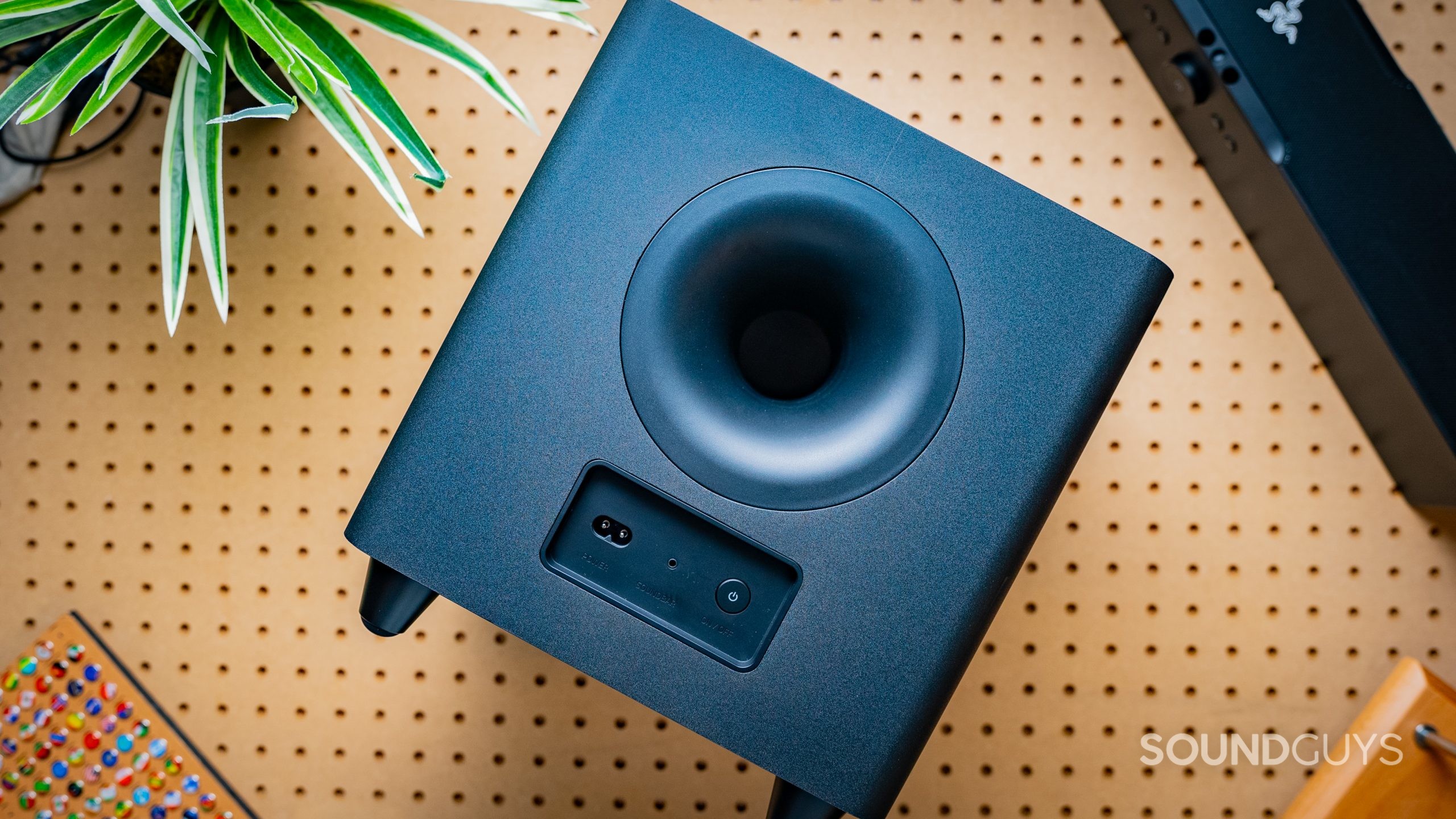
There are several ways to connect your subwoofer to the rest of your stereo or home theater system :
- Plug an audio interconnect cable into your receiver’s subwoofer output and into the sub’s line input.
- If there’s no dedicated sub-out to connect to, you can feed the subwoofer a full-range left and right line level signal from your preamp or receiver and rely on the subwoofer for low pass filtering and mono summing.
- If there’s no line level output available on your equipment, you’ll need a sub with high (speaker) level inputs, which will be four clamps or binding posts, so you can use speaker wire to connect the left and right speaker outputs from your amplifier or receiver to the sub. Then, run speaker cables from the sub to the main speakers.
- Plug your subwoofer into a wall outlet and power it on.
- Power your soundbar on.
- The sub’s LED should flash while connecting to the soundbar.
- Wait for the LED to shine green, indicating it’s connected to the soundbar.
Do you need a subwoofer?
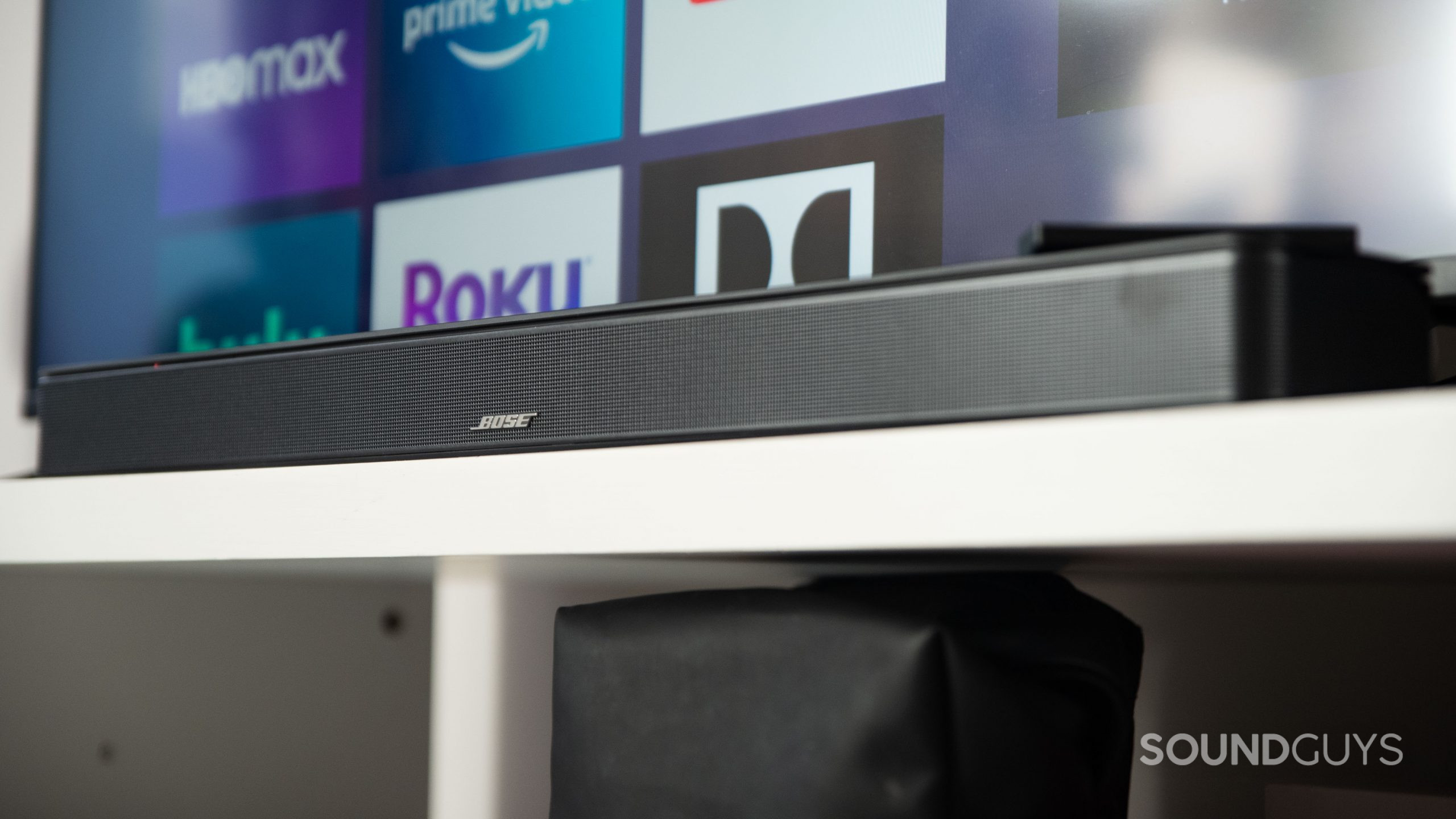
If you want to feel the impact of an on-screen explosion, bookshelf speakers just won’t cut it. Adding a sub to your speaker system relieves the other speakers in your setup from reproducing these demanding low frequencies. High-passing the signal to your other speakers means you’ll notice voices come through more clearly, and increasing the volume of your sound system doesn’t introduce distortion the same way it did without a subwoofer.
Frequently asked questions about subwoofers
Subwoofers should not require a burn-in period. You can enjoy your sub right away.
A subwoofer has a much more limited frequency range than a full range loudspeaker. Subwoofers can usually only reproduce frequencies below 150Hz, while bookshelf speakers might produce a frequency range of 50Hz-20kHz.

- Forum Listing
- Marketplace
- Advanced Search
- Reviews, Data and Member contributions
- How-To Articles Provided by our members
A brief look at excursion vs. frequency of various speaker sizes
- Add to quote
One thing I like about this graph is that it shows the true key to actual midbass output is high effeciency as excursion is pretty low for a 8inch driver from 80-250hz.
Nice graph. One thing you might want to add is reference scales (ie dB(A) dB(B) dB(C) etc. etc.) that way, you'll understand the difference a bit more, seeing as 100dB at 2-3kHz will start you're ears slowly bleeding (because we are most sensitive here), whereas 100dB at 20Hz is barely enough to lift one's skirt.
~thematt~ said: seeing as 100dB at 2-3kHz will start you're ears slowly bleeding Click to expand...
One thing I like about this graph is that it shows the true key to actual midbass output is high effeciency as excursion is pretty low for a 8inch driver from 80-250hz. Click to expand...
Nice graph.
mvw2 said: We do perceive different frequencies at different levels. You could say measured flat isn't human flat. Click to expand...
Doubling the drivers and power will give a rough 6db increase, cutting necessary excursion in half. That's about the only way you'll get loud and low cleanly with 7" drivers
Doubling the drivers and power will give a rough 6db increase, cutting necessary excursion in half. That's about the only way you'll get loud and low cleanly with 7" drivers Click to expand...
Me likey. What are the y units? mm?
Yeah millimeters.
sorry to refloat this four year thread, but the graph isn't showing anymore. would somebody upload it please?
Interesting stuff. Now where's that graph?
as a bump: I am pretty sad to see a lot of the old threads without any pic support, I'm not sure if it's a technical issue or not, especially since the oldies are goldies haha
- ?
- 131.8K members
Top Contributors this Month

- Search forums
- WANTED: Happy members who like to discuss audio and other topics related to our interest. Desire to learn and share knowledge of science required. There are many reviews of audio hardware and expert members to help answer your questions. Click here to have your audio equipment measured for free!
- Audio, Audio, Audio!
- Speaker Reviews, Measurements and Discussion
Woofer excursion
- Thread starter Roy_L
- Start date Feb 13, 2024
Active Member
- Feb 13, 2024
Over the years, especially with 2way speakers, I came to appreciate long excursion (travel distance) mid-woofers. There are speakers which seem to be capable of high dynamic range, while others of the same size just bottom out under pressure. (For example, in playing Pink Floyd's song "Hey You" loudly, when the drums kick in at 1:18. Some speakers can take it easily, while others could be seriously damaged). Is there a trade-off here? Or are long excursion drivers just better? Also, is this something detailed under a driver's specs?
Grand Contributor
sergeauckland
Major contributor.
One difficulty with long-throw drivers is maintaining linearity over a long magnetic gap. There are two main methods, having a long coil in a short magnetic gap, which means that there's always the same amount of coil in the gap over the excursion, or having a short coil in a long magnetic gap, which accomplishes the same thing. The difference is in the size and shape of the magnet, and the resulting cost, and the reduction in sensitivity, as in both cases, either a lot of the coil or the magnet is 'wasted', leading to low sensitivity. However this gives good linearity and I'm always a bit suspicious of small high-sensitivity drivers as they will inevitably be compromised in LF distortion due to limited extension. Large loudspeakers don't need much excursion to shift air, so are less limited in sensitivity and distortion, but of course are larger and more costly, and result in bigger boxes which may limit their commercial appeal. As I'm not that bothered about enclosure size, I prefer a big driver in a big box, but then big drivers need crossing over fairly low, so need three or four ways, so more complexity and expense. Isn't loudspeaker design just balancing compromises? S.
* Small Enclosure Volume * (Deep) Bass Extension * High Sensitivity Pick two. Click to expand...
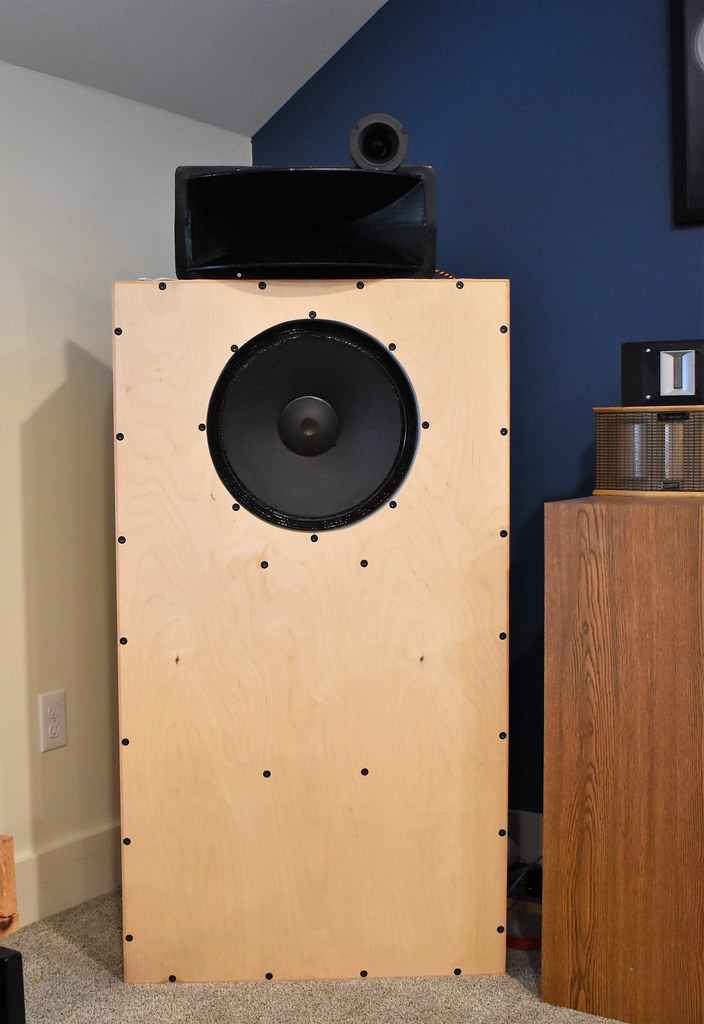
Roy_L said: Also, is this something detailed under a driver's specs? Click to expand...
Similar threads
- Dec 22, 2023
- terryforsythe
- Jan 27, 2024
- Digital_Thor
- Oct 28, 2023
- DIY Audio Forum
- Mar 15, 2024
- Feb 8, 2024
October 27, 2023
What Subwoofer Has The Most Excursion?
Home theater enthusiasts and audiophiles alike know that a key element to achieving superior audio quality is a good subwoofer. ...
Home theater enthusiasts and audiophiles alike know that a key element to achieving superior audio quality is a good subwoofer . It is widely recognized that subwoofers, essential components of a home theater’s sound system , are responsible for delivering the low-frequency signals that add richness and depth to the entire audio experience. Understanding the aspects that determine a subwoofer’s performance, such as excursion, is crucial for the optimum home theater setup.
One subwoofer that has attracted considerable attention and acclaim in the home theater community is the Thunder 1000000. The Thunder 1000000, unparalleled in size and performance, has set the record for the largest subwoofer ever produced. Its impressive 60-inch diameter and exceptional 6 inches of peak-to-peak cone excursion make this subwoofer nothing short of awe-inspiring.
This article explores the importance of excursion in subwoofers, the exceptional excursion capabilities of the Thunder 1000000, the factors that make a good subwoofer, and various aspects related to excursion including its measurement, potential for damage, and how size affects it. We will also look into some of the subwoofers, aside from the Thunder 1000000, with the most excursion and whether large excursion subwoofers are worth the investment.
Table of Contents
Does Excursion Matter in Subwoofers?
Excursion undoubtedly plays an essential role in the overall performance of a subwoofer. It is the term used to describe the distance a speaker cone or diaphragm moves out from its resting, or neutral, position. The greater the excursion, the more low-frequency depths the subwoofer can potentially provide to your home theater.
Furthermore, the excursion directly impacts the ‘loudness’ of the sound. A subwoofer with higher excursion capability can handle more powerful signals, thereby producing louder sounds without distortion. Thus, excursion designates the potential for superior output and clarity in a home theater’s sound system.
However, it’s critical to note that excursion isn’t the sole determinant of a subwoofer’s quality. Although it helps in achieving deeper and louder bass, other factors such as amplifier power, cabinet design, and the driver’s cone material also contribute to the overall performance. So while excursion is undeniably important, one should consider it as part of a broader specter when assessing subwoofers.
Lastly, while too little excursion might result in weak bass and poor overall performance, bigger isn’t always better. Overly large excursions can result in sound distortion and potential damage to the subwoofer, especially if not appropriately managed. It is therefore crucial to balance excursion capabilities with other key performance factors for a truly high-performing subwoofer.
How Much Excursion Does The Thunder 1000000 Have?
The Thunder 1000000 is a record holder in terms of excursion capabilities. It boasts an impressive 6 inches of peak-to-peak cone excursion, providing it with considerable power and performance in delivering rumbling, resonance-rich bass to any home theater system.
Such a high excursion value allows the Thunder 1000000 to reach extremely low frequencies with undiminished vigor. This means that the bass notes prove to be deeper and richer, adding great depth and extremeness to the overall audio experience of your home theater.
Coupled with its massive 60-inch diameter, the Thunder 1000000’s generous excursion capacity enables it to produce immense volumes of sound. This makes it exceptionally effective in replicating those earth-shaking cinematic sounds like explosions, making it a favorite among those seeking a truly immersive home theater experience.
However, it’s essential to remember that while these extraordinary excursion capabilities increase the Thunder 1000000’s power, it also requires a meticulously designed and sturdy cabinet, along with a robust amplifier to harness this power effectively. Superior excursion capabilities demand superior support systems; the Thunder 1000000 is undoubtedly an exceptional subwoofer, but it needs equally exceptional equipment to deliver its full potential.
What Makes a Good Subwoofer?
A good subwoofer is more than just high excursion or large dimension. It should effectively reproduce the low-frequency sounds essential for a complete cinematic experience in your home theater. Moreover, it should deliver these sounds clean, precise, and free of distortions.
Excursion is indeed a crucial aspect to consider while buying a subwoofer, as it determines the depth of bass notes that the unit can render. It also impacts how loud the subwoofer can play without causing distortions. However, other factors are equally important. For instance, the power of the amplifier and the size and quality of the driver influence the overall sound quality to a great extent.
Another critical component is the design of the subwoofer enclosure. It determines how the bass waves will react and propagate in the room. Therefore, a well-designed enclosure is key for good sound. Moreover, the material of the cone also influences the quality of the sound. It must be durable and stiff to handle extreme vibrations, yet light enough to move freely.
Lastly, a feature we often overlook is the subwoofer’s connectivity options. A good subwoofer should offer a range of connectivity options, such as RCA, speaker level inputs, and others. This provides greater flexibility and makes setup easier. Therefore, while assessing a subwoofer, look beyond just excursion and consider a variety of factors to ensure a well-rounded performance.
How is Excursion Measured in Subwoofers?
In subwoofers, excursion is measured as the linear distance a speaker cone travels from its resting position. This is usually expressed in millimeters or inches. Notably, the measurement is taken as peak-to-peak excursion, meaning the total distance traveled by the cone from its maximum outward position to its maximum inward position.
Typically, manufacturers provide the subwoofer’s excursion measurements in the product’s specifications. However, one must remember that these are often calculated under ideal circumstances and may not represent the excursion value you achieve in real-world use within your home theater system.
Furthermore, there are different ways to quantify subwoofers’ excursion. Some manufacturers use the Xmax value, which refers to the maximum linear cone movement in one direction before distortion becomes unacceptable. Conversely, others use the peak-to-peak value, which signifies the total movement of the cone in both directions. Understanding these terms can help you better evaluate the subwoofer’s excursion capabilities.
It’s also important to understand that high excursion values alone do not automatically indicate superior performance. The efficiency with which a subwoofer uses its excursion potential plays a significant role. For example, a subwoofer with lower excursion but more efficient energy handling can outperform a similar unit with higher excursion but less efficient energy management.
Can Too Much Excursion Damage a Subwoofer?
While high excursion values can enable a subwoofer to deliver deeper and louder bass, it is also true that excessive excursion can potentially damage the subwoofer. When the subwoofer operates beyond its optimal parameters, it can cause the voice coil to heat up and eventually fail or even damage the cone’s mechanical parts.
Over-excursion, when a subwoofer operates beyond its excursion limits, can lead to undesirable sound distortion and can even physically damage the unit. This typically occurs when the subwoofer is driven too hard, beyond what its components are designed to handle.
The key to preventing damage due to over-excursion is to ensure the subwoofer is matched well with the rest of the sound system, particularly the amplifier. By doing so, you can prevent the amplifier from sending signals too powerful for the subwoofer to handle.
Additionally, it’s vital to use the subwoofer within the manufacturer’s recommended guidelines to preserve its longevity. Regular maintenance and appropriate application of power can protect the subwoofer from adverse effects of over-excursion, maintaining the quality and performance of your home theater’s sound system.
Does Size Affect Subwoofer Excursion?
The relationship between the size of a subwoofer and its excursion capability is a complex one. Generally, a larger subwoofer can accommodate a larger cone or diaphragm, which can indeed move more air and thereby provide higher excursion capabilities. However, size alone is not a definitive indicator of excursion.
A larger subwoofer does not automatically entail a higher excursion. Other factors, such as the quality of the driver, design of the cone, and most importantly, the subwoofer’s engine – which comprises the magnet structure, voice coil, and suspension – play a critical role in determining the overall excursion capabilities.
For example, a smaller subwoofer with a high-quality, well-designed engine can potentially provide a more significant excursion than a larger subwoofer with an inferior engine. Thus, while size is a factor, it’s equally, if not more, essential to consider the engine quality, along with other facets of subwoofer design when assessing its potential excursion capabilities.
Moreover, the size of a subwoofer will influence other aspects of its performance and usability. Large subwoofers can deliver profoundly low frequencies and fill up bigger spaces with sound. On the other hand, they often require more power and can be challenging to install and integrate into an existing home theater setup.
Which Subwoofers Have The Most Excursion?
While the Thunder 1000000 is exceptional, with a stunning 6 inches of peak-to-peak cone excursion, there are several other subwoofers on the market with commendable excursion capabilities. For instance, the JL Audio 13W7 has a maximum excursion value of 1.15 inches, which for its more standard size of 13.5 inches is quite remarkable.
Another great example is the Sundown Audio ZV5 series of subwoofers, with Xmax values approaching 30mm – a highly notable figure for any conventional subwoofer. These high-excursion subwoofers are very capable of delivering thunderous bass to enhance any home theater experience.
Funk Audio’s V Series, specifically the 21.0 model, delivers another outstanding excursion, making it an excellent choice for a high-powered home theater setup. However, it’s essential to remember that high excursion values don’t automatically guarantee superior performance. A subwoofer must be able to use its excursion potential effectively to deliver accurate, distortion-free bass.
Remember, the best subwoofer is not the one with the highest excursion, but the one that best fits your particular needs and setup. Selecting a subwoofer should consider many factors, including the size of the room, your audio preferences, and the power of your existing equipment.
Are Large Excursion Subwoofers Worth It?
Large excursion subwoofers can deliver a heart-thumping bass that adds depth and richness to the audio experience in your home theater setup. But is their generally higher price tag justified? To answer this question, one must consider individual specific requirements and preferences.
The main advantage of large excursion subwoofers is their capacity to reproduce very low-frequency sounds with high clarity and volume. If you are a bass enthusiast who enjoys experiencing the depth and thrill of earth-shaking bass, then a high-excursion subwoofer is indeed worth the investment.
However, it’s important to remember that subwoofers capable of high excursions demand equally capable and compatible equipment to harness their full potential. They require a powerful amplifier, sturdy and well-designed cabinet, and superior engineering to provide distortion-free sounds.
Moreover, such subwoofers often consume more power and take up considerable space. If size and power consumption pose limitations for you, smaller, less overpowering subwoofers may do a fairly good job at a fraction of the price.
So, are large excursion subwoofers worth it? If you have the budget, space, and desire for extraordinary bass, then investing in a high-excursion subwoofer can elevate your home theater experience. However, if your needs are more modest, there are many excellent subwoofers on the market with less thrilling but still impressive performances.
In conclusion, excursion is a crucial characteristic to consider when purchasing a subwoofer for your home theater system. It can significantly impact the subwoofer’s bass delivery capabilities and overall sound production. However, it is essential to remember that other factors, such as the quality of the driver, the design of the subwoofer enclosure, and its compatibility with the current system, are equally vital for achieving an optimal sonic experience.
High-excursion subwoofers like the Thunder 1000000 can deliver immense power and performance, but they also need robust support systems and careful handling. On the flip side, smaller, less mighty subwoofers may provide a satisfying experience, given the right setup and expectations.
Choosing the right subwoofer comes down to understanding your specific needs and constraints, and then selecting a product that best fits those requirements. Whichever subwoofer you choose, we wish you a thrilling and immersive home theater experience!
Posts You May Enjoy...

Are Bluetooth Speakers Any Good?

How To Choose A Subwoofer For A Home Theater

12 Inch Vs 10 Inch Subwoofers – What’s Better?
HomesTheatre specializes in creating immersive home theaters and offers expertise in music and PC setups. Founded in 2021, we've dedicated nearly half a decade to enhancing audio-visual experiences with our tailored solutions for enthusiasts and casual users alike.
© 2023 HomesTheatre . ALL RIGHTS RESERVED.
Privacy Policy | Terms Of Service
16" High Excursion Subwoofer
Advanced acoustics.
The new high-performance Klipsch subwoofers worthy of the Reference Premiere moniker are built with our groundbreaking acoustic technology and are, pound for pound, some of the best subwoofers Klipsch has ever created.
Balanced Performance
Compared to other premium subwoofers on the market, Reference Premiere subwoofers strike an optimal balance between amplifier power, driver capability and cabinet volume for maximum output, detail, and frequency extension.
Ground-Up Driver Design
A redesigned driver aimed at delivering the ultimate low-frequency experience, the Cerametallic ™ woofers are incredibly powerful and efficient, outperforming the competition.
High-Efficiency Class D Amplifier
The built-in, high-efficiency amplifier features an analog preamp design, which maintains the original signal path for cleaner, true-to-source reproduction. The Class D output stage ensures maximum output, detail and low frequency power.
Monster Bass Anyplace
Featuring a front-firing driver, you can place your Reference Premiere subwoofer anywhere you want. The proprietary internal geometry with a new Aerofoil front slot port minimizes turbulence for crisp, tight bass.
Easy-to-Use Controls:
- Low-Pass Crossover and Variable Phase: Tune your subwoofer to your Klipsch speakers for the ideal level of bass for the space.
- Line Level/LFE RCA Inputs: Ensures compatibility with your AV receiver.
- Use Inputs Simultaneously: Both RCA and wireless inputs can be utilized at the same time, giving you the ability to use a single subwoofer with multiple systems.
- 1/2-Watt Standby Mode: Exceptional efficiency on and off to reduce your energy costs.
Go Wireless
The Klipsch WA-2 Wireless Subwoofer Kit (sold separately) produces high-resolution wireless connectivity for easy placement anywhere in your room. Connect up to four WA-2 wireless kits to your Klipsch Reference Premiere subwoofers in a single room for a completely wireless connection and the best bass in the world.
Design Upgrades
Scratch resistant ebony vinyl finish looks like real wood and covers the entire cabinet. Rounded corners, shock-absorbing rubber feet, steel grille posts and a durable woven cloth grille ensure a premium aesthetic.
- Rounded corners provide a more modern aesthetic
- Double thick grille for additional excursion
- All-new foot design
Better Together
Pair your new Reference Premiere subwoofer with any Klipsch speaker component with ease.
We're so confident in the power and performance of these subwoofers that we're including a five year warranty.
Reference Premiere Subwoofers
Learn more about the new subwoofers worthy of the Reference Premiere name.
- RP-1600SW Subwoofer Spec Sheet
- RP-1600SW Subwoofer Manual
Product Support
Designed and engineered with pride in Indianapolis.
©2024 Klipsch Group, Inc.
A VOXX International Company California Supply Chain Transparency Disclosure
- Search Posts
- Loudspeakers
- High Excursion 8 Inch Woofer. Is Their Such A Beast?
- Thread starter OMNIFEX
- Start date 2003-12-18 1:01 am
- 2003-12-18 1:01 am
Looking to replace some foam rot 8 inch woofers with high excursion 8 inch woofers. The cabinets are; 19 inches tall 10.5 inches wide 7.5 inches deep Power is not an issue, for I can feed them anywhere from 100 to 400 watts continuous per channel Any suggestions and/or recomendations would be greatly appreciated.
More options
Kelticwizard, diyaudio moderator emeritus.
- 2003-12-18 1:05 am
This might be a guide. The trick is in finding one. http://www.diyaudio.com/forums/showthread.php?postid=284436#post284436
- 2003-12-18 1:11 am
Peerless 8" HDS woofers have 5.5mm of Xmxax, thats quite close to high excurtion as an 8" is going to get, i also think that the adire AV8 has a reasonable xmax and it also models very nicely, something i personally am a bit causious of.
- 2003-12-18 1:55 am
Try this, Steve says 4.9mm xmax http://www.apexjr.com/SuperSub.htm Andrew
- 2003-12-18 2:37 am
I've found a few... There's the ApexJr Super 8 mentioned above... There's the Adire AV8 mentioed above... There's a Tang Band one that graphs really good for real cheap, of which, as mentioned above, can be a little skeptical. Also, you could check out JL Audio 8W0, or 8W4 etc. I know they're good. I believe the cheapest are probably the Tang Band and the ApexJr. Hard to judge how good they are without trying them. Pete
- 2003-12-18 2:57 am
Someone like John at Stryke Audio needs to start carrying the high-excursion 8" that TC-Sounds builds.
- 2003-12-18 3:35 am
Have you had a look at these ? http://www.paudio-europe.com/products/db_product_1_27_tm-8.htm
- 2003-12-18 3:39 am
Cannon sound, in OZ have the 12" version on sale, I wish i could justify buying a pair or two. They might be just the thing for a dipole sub
- 2003-12-18 4:38 am
That PAudio TM-8 certainly looks like a great 8" woofer. A mail order house in America sells the 10" and 12" version of it. The 12 inch is $420 and the 10 inch is $390. I think we see a pricing trend here....
- 2003-12-18 4:46 am
Very cheap, and quite high excursion is the TB W8-740c, found at www.nuera-acoustic.ca. Inexpensive, and they ship out of both the US and Canada, so shipping isn't bad at all. Their listed 12mm xmax is right on the money, being measured by the (vc height - airgap height) /2 method. Very good power handling, despite their low rating in the datasheet. I've personally pushed 200W RMS (brownish noise) through one for an hour or so with no ill effects. I'd like to see a little better suspension travel out of them to go with the 12mm one-way xmag, but it's about as good as can be expected within the confines of a small 8" diameter basket and a smallish diameter spider. I'd estimate it at about 16mm or so. At any rate, an excellent performer for its size.
- 2003-12-18 5:09 am
There is the Eclipse 87081.4 with a huge excursion. Here is the home page to download the pdf specs: http://www.eclipse-web.com/products/speaker/87001dvc/87081_4.html Seems to be selling reasonably cheaply on Ebay: http://search.ebay.com/search/searc...=&ebaytag1code=0&st=&SortProperty=MetaEndSort Does not mention symmetrical magnetic system-though I think it probably has one. Does not mantion SPL-some of these extremely long throw designs can have really low SPL's.
- 2003-12-18 5:20 am
ThingyNess said: Their listed 12mm xmax is right on the money, being measured by the (vc height - airgap height) /2 method. Very good power handling, despite their low rating in the datasheet. I've personally pushed 200W RMS (brownish noise) through one for an hour or so with no ill effects. Click to expand...
- 2003-12-18 6:26 am
Peerless 8" XLS Peerless have a 830491 which is a 8" XLS with an Xmax of over 10mm based on the 8" HDS and is available in Australia from WES Components: http://www.wescomponents.com/ Some details: http://www.d-s-t.com.au/Data/Peerless/830491.pdf
Attachments
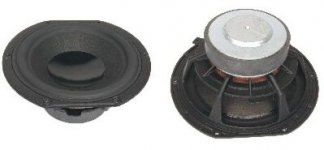
- 2003-12-18 1:42 pm
Thanks Everyone! So far, the ones that work best in this enclosure are; TC2 8 (-3db 28.19Hz) www.tcsounds.com TB W8 740 C (-3dB 35.79Hz) I'll post the graph later................... P.S. Its a Reflex cabinet
- 2003-12-18 1:43 pm
What are these speakers, 2 way? 3 way? Very high excusion woofers, even 8" ones, are usually more designed for subwoofer applications, and likely wouldnt have as good of upper bass, lower midrange characteristics, IF they would need to do this in youre system
- 2003-12-18 1:49 pm
That's fine. They will be used for frequencies 70 - 25Hz. I have another set of speakers I can use for mains, and, these will be turned into subs. This is for my mom's video system, so, she perfers to keep her original cabinets. I figure I'll give her my old Soundcraftsmen 7502 lying in the corner for the bass, and, use a Sansui AU X 77 for the mains............... Got an old DOD crossover that will fit in nicely.
- 2003-12-18 1:54 pm
Where are you from by the way? I pride myself on having a higher knowlege of geography than a typical american (not very hard!), but can't place youre flag
- 2003-12-18 1:57 pm
I'm from Jamaica.
- 2003-12-18 2:05 pm
well, sounds like you've found youre driver. One thing I'd say, the tc2 has a listed xmax of over 16mm, I'm sure that is two way, which would bring its one way xmax to over 8mm, still very very high for an 8" driver.
- 2003-12-18 2:19 pm
BestCarAudio.com
Showcasing the Best in the Mobile Enhancement Industry
A Detailed Look at the Speaker and Subwoofer Xmax Specification
August 6, 2021 By BestCarAudio.com
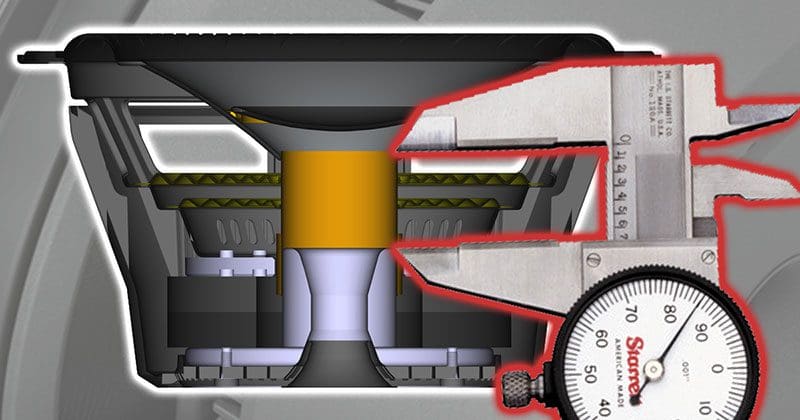
For car audio enthusiasts who’ve invested time studying the Thiele/Small parameters of speakers and subwoofers, you’ll know there is a specification called Xmax. This variable, typically expressed in millimeters or inches, is intended to describe the one-way excursion capability of the driver. Put another way, it’s the distance the cone can move forward or rearward from its rest position before distortion overwhelms the signal being produced.
Mechanical Xmax Calculations
The simplest way to calculate the Xmax specification is to subtract the thickness of the top plate from the height of the voice coil winding and divide it by two. This calculation describes how far the woofer (or midrange or subwoofer ) cone can move forward while keeping the voice coil inside the magnetic gap. If and when the coil attempts to move out of the gap (determined by the thickness of the top plate), the strength of the magnetic field is dramatically reduced and the output of the speaker becomes non-linear. If the audio signal being produced by the speaker isn’t the same as the signal sent from the amplifier, significant distortion is being added to the signal, and your music won’t sound right.
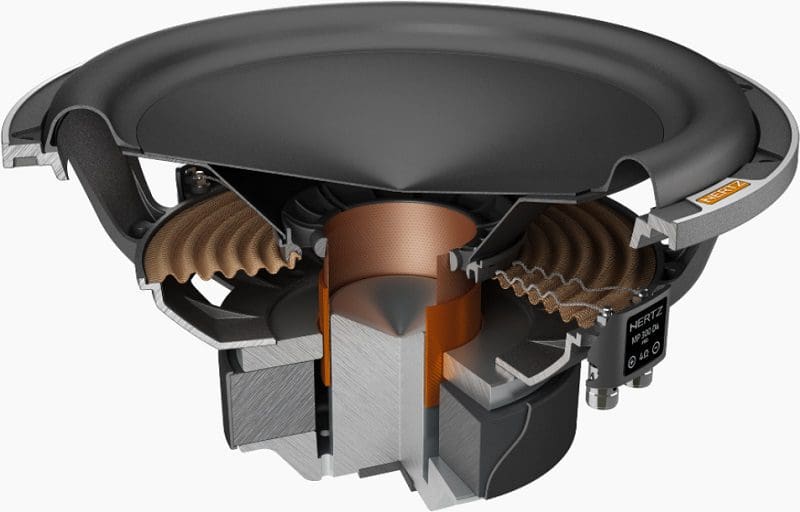
It’s worth having a baseline for values that are considered normal and impressive in terms of Xmax. Tweeters seldom have an Xmax specification, but that doesn’t mean it’s not a value that can be calculated. For example, a linear excursion of plus or minus 0.2 mm (0.0079 inch) would be an excellent specification for a tweeter. For a small 3- or 4-inch midrange driver, an Xmax of plus and minus 2 mm would be good, and greater than 4 mm would be excellent. For a 6.5-inch mid-woofer intended for a door speaker application, an Xmax value of 4 mm would be good, and anything above 8 mm would be exceptional.
Subwoofer excursion capability increases dramatically as the price of a driver increases. For entry-level 10- and 12-inch subwoofers, rated for 300 to 450 watts, an Xmax of 10 to 12 mm is good. Stepping up to mid-level woofers with power ratings between 500 and 600 watts typically results in the Xmax spec jumping up to 14 or 16 mm in each direction. The cream of the crop in subwoofers offer Xmax capabilities beyond 18 mm, with some drivers capable of more than 24.5 mm (1 inch) of excursion in each direction. Shallow-mount subwoofers typically scale these values down a bit, with mid-level drivers capable of 8 to 10 mm of excursion and premium solutions capable of more than 15 millimeters.
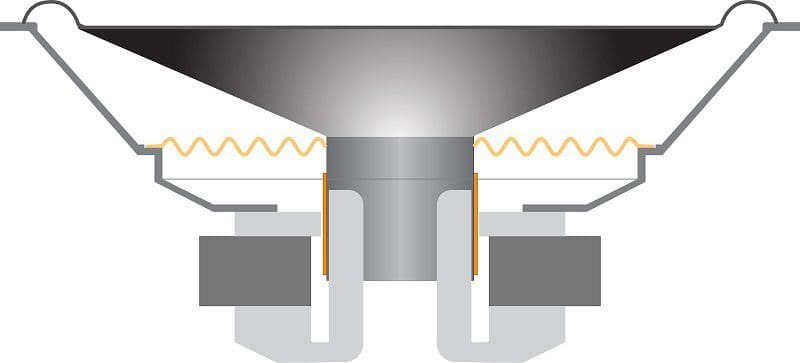
Those who care less about sound quality and are interested only in achieving maximum sound pressure levels can continue to increase the power to a speaker beyond the Xmax value. In this scenario, peak SPL measurements are typically all that matter, so sound quality and accuracy take a back seat.
Xmax Isn’t Always a Calculation
A second way to specify the Xmax parameter involves using acoustic test equipment and laser-based cone excursion measurement. Using this method, a signal is fed to the driver being tested at an increasing level until the speaker’s output reaches a distortion level of 10%. These performance-based measurements are crucial as they take into account non-linearities caused by limits in the compliance of the speaker’s suspension components.
For example, if a driver has a 16 mm top plate and a 32 mm voice coil height, the calculated Xmax would be 8 mm. Suppose the surround on the driver is very narrow or stiff and starts to limit cone travel at an excursion level of 5 mm. Once again, the output audio signal won’t replicate the signal from the amplifier, and significant harmonic and intermodulation distortion will be added to the output. The speaker also won’t play any louder. The surround or the spider can cause compliance-based excursion limiting, and these characteristics are usually the limiting factors in how loudly a speaker or subwoofer can play. In the car audio industry, very few manufacturers use the Xmax+10% specification method as investing in the test equipment is very expensive.
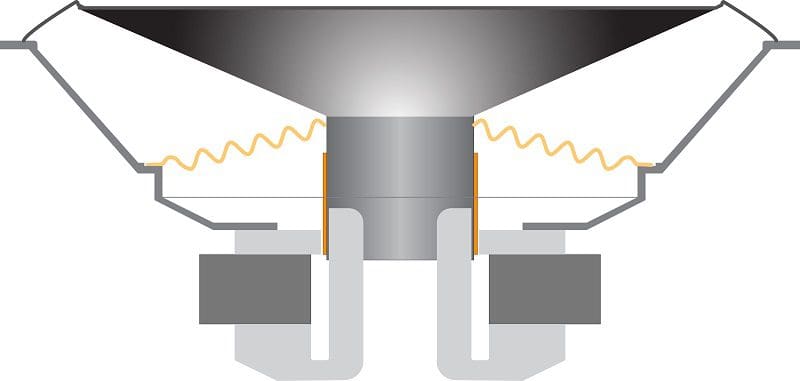
Though it isn’t as common as it was years ago, another mechanical measurement affects how loudly a speaker can play. If the bottom of the voice coil former runs into the bottom plate of a speaker, you’ll hear a very sharp snapping sound. Of course, this limits excursion and can damage the former very quickly. This situation happens when the suspension components aren’t stiff enough or if the driver is designed to be extremely shallow and there isn’t adequate space at the bottom of the driver.
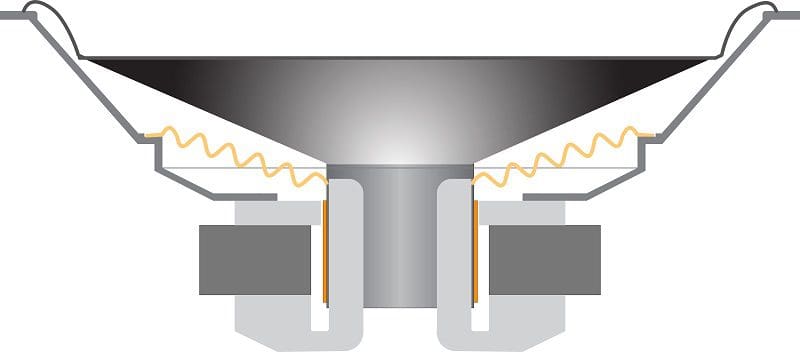
One Last Thought on Xmax Specifications
If you’re shopping for a subwoofer, the Xmax spec isn’t the be-all, end-all in determining how loudly the subwoofer system will play. The way the driver interacts with the enclosure plays a huge role in determining the audio system’s effective efficiency and low-frequency extension. Check out our articles on speaker specifications and subwoofer enclosure designs for more insight into this topic.
When it’s time to choose the right subwoofer for your car or truck, drop by your local specialty mobile enhancement retailer and talk with them about your expectations and the speakers and subwoofers that are the best for your application. Be sure to audition one of their demo vehicles to see if the subwoofer solution meets your performance goals.
Share this:

About BestCarAudio.com
BestCarAudio.com Magazine is the premier resource for accurate information about car audio and vehicle accessory upgrades. We are staffed by mobile enhancement industry veterans who are retail store owners, world-class installers, product developers, and trainers. Our Editor-in-Chief, Dave MacKinnon, is the industry's best-known writer and professional product reviewer. He uses his decades of experience to ensure that our published content is accurate, informative and entertaining. From car audio systems, lighting, remote starters, and window tint to how best to enhance your motorcycle, boat or powersports vehicle, we cover every aspect of the mobile enhancement industry in explicit detail to ensure that you choose the best upgrades possible.
Popular Categories
- Window Tint
- Remote Car Starters
- Vehicle Insights
- Radar Detectors
Supporting Manufacturers
- Rockford Fosgate
- Dealer Locator Guidelines
Miscellaneous
- Profile Request
- Press Release Guidelines

- Electronics
- Car & Vehicle Electronics
- Car Electronics
- Component Subwoofers
No featured offers available
- Quality Price,
- Reliable delivery option, and
- Seller who offers good customer service

Image Unavailable

- To view this video download Flash Player
WOOFER, 8"", HIGH Excursion, 120W, 4 OHM
About this item.
- <b>Price For:</b> Each <b>Product Range</b>: -
Similar items that may deliver to you quickly

Compare with similar items
Product description.
- Rigid lightweight paper cone
- Treated foam surround
- Bumped magnet and vented pole piece
- Power capacity: 120W/240W RMS/peak
- Frequency response: 25Hz ~ 1KHz
- Nominal impedance: 4Ω
- Voice coil diameter: 2"
- Magnet weight: 47oz.
- Sensitivity: 87dB W/M
- Vas: 30.43 liters
- Mms: 59.78g
- Xmax: 8mm (one-way)
- Magnet gap height: 8mm
- Overall frame diameter: 8.25"
- Required cutout: 7.125" diameter
- Mounting depth: 4.5"
Looking for specific info?
Product information, customer reviews.
Customer Reviews, including Product Star Ratings help customers to learn more about the product and decide whether it is the right product for them.
To calculate the overall star rating and percentage breakdown by star, we don’t use a simple average. Instead, our system considers things like how recent a review is and if the reviewer bought the item on Amazon. It also analyzed reviews to verify trustworthiness.
- Sort reviews by Top reviews Most recent Top reviews
Top reviews from the United States
There was a problem filtering reviews right now. please try again later..
- Amazon Newsletter
- About Amazon
- Accessibility
- Sustainability
- Press Center
- Investor Relations
- Amazon Devices
- Amazon Science
- Start Selling with Amazon
- Sell apps on Amazon
- Supply to Amazon
- Protect & Build Your Brand
- Become an Affiliate
- Become a Delivery Driver
- Start a Package Delivery Business
- Advertise Your Products
- Self-Publish with Us
- Host an Amazon Hub
- › See More Ways to Make Money
- Amazon Visa
- Amazon Store Card
- Amazon Secured Card
- Amazon Business Card
- Shop with Points
- Credit Card Marketplace
- Reload Your Balance
- Amazon Currency Converter
- Your Account
- Your Orders
- Shipping Rates & Policies
- Amazon Prime
- Returns & Replacements
- Manage Your Content and Devices
- Recalls and Product Safety Alerts
- Conditions of Use
- Privacy Notice
- Consumer Health Data Privacy Disclosure
- Your Ads Privacy Choices

IMAGES
VIDEO
COMMENTS
Excursion is defined as how far the cone of a speaker linearly travels from its resting position. Lower frequency drivers or subwoofers are designed to move more air and have more excursion than those of higher frequency. If a speaker is pushed beyond its limits, overexcursion, or "bottoming out," can occur as the voice coil either slips out of the magnetic gap or hits the bottom of it.
50 mm of excursion in a compact 8" for the price of a 15" with 5mm would be a quick sell to me, if it was any good. The value is in the larger woofers with half decent excursion, a Tc sounds epic 12" for example is only 30$ more expensive than a tc sounds epic 8". Like.
High excursion subwoofers offer accuracy, precision, and an immersive listening experience, while SPL subwoofers deliver maximum volume output and bone-rattling bass. Consider factors such as sound preference, space requirements, amplifier compatibility, and budget when making your decision. And remember, there is no substitute for experiencing ...
No. Matter support. Yes. No. At the heart of the HomePod 2 is a "high excursion" woofer that Apple promises packs deep, rich bass. In addition, it offers a 20mm diaphragm with its bass EQ mic that is dynamically able to tune low frequencies in real-time. As Apple exclaims: "Superclean bass. Fills the room. Boom."
The small woofer's excursion is no longer a limiting factor in how loudly the system will play when low frequencies are filtered from the signal driving it. The midrange is much cleaner, and the overall system sounds like a large, full-range speaker. ... Setting the subwoofer's crossover frequency too high also results in poor integration ...
Dayton Audio HTS545HE-4 21″ Kraken High Excursion Subwoofer with 5″ Voice Coil 4 Ohm. Buy on Amazon. The HTS545HE-4 21″ Kraken High Excursion Subwoofer cranks out low-end bass like nothing else, thanks to its 6.5″ voice coil, 5″ diameter, and 31″ excursion. The 4 ohm impedance works well with amplifiers, but be careful to monitor ...
In addition, most high excursion subwoofer drivers suffer from lower midbass response and tend to lack impact and punch, the HTS545HE-4 has the motor strength to produce unbelievable midband efficiency, control, and output which eliminates the need for additional midbass systems in large home theaters. Built to last a lifetime
Subwoofers employ large, high excursion drivers to move the air necessary to generate bass. A subwoofer is a type of loudspeaker designed specifically to reproduce low frequencies. Conventional, full-range speakers try to cover as much of the frequency range as possible, up to (or beyond) 20kHz, but a subwoofer is intended to fill in the ...
The Reference Series high excursion subwoofers from Dayton Audio will generate incredible bass response with unparalleled detail, control, and SPL capability...
Although subwoofers offer a good amount of excursion, midrange woofers and tweeters do lack considerably. Most midrange woofers have excursion levels in the 3mm to 6mm range. ... One thing I like about this graph is that it shows the true key to actual midbass output is high effeciency as excursion is pretty low for a 8inch driver from 80-250hz.
Feb 13, 2024. #1. Over the years, especially with 2way speakers, I came to appreciate long excursion (travel distance) mid-woofers. There are speakers which seem to be capable of high dynamic range, while others of the same size just bottom out under pressure. (For example, in playing Pink Floyd's song "Hey You" loudly, when the drums kick in ...
For example, a smaller subwoofer with a high-quality, well-designed engine can potentially provide a more significant excursion than a larger subwoofer with an inferior engine. Thus, while size is a factor, it's equally, if not more, essential to consider the engine quality, along with other facets of subwoofer design when assessing its ...
16" High Excursion Subwoofer. Toggle Video Mute. Toggle Video Pause. Advanced Acoustics. The new high-performance Klipsch subwoofers worthy of the Reference Premiere moniker are built with our groundbreaking acoustic technology and are, pound for pound, some of the best subwoofers Klipsch has ever created.
Buy this product as Renewed and save $334.00 off the current New price. Klipsch Reference Premiere RP-1200SW 12" High Excursion Subwoofer (Renewed) $595.00 & FREE Shipping. (2) Works and looks like new and backed by the Amazon Renewed Guarantee.
MONSTER BASS ANYPLACE: Featuring a front-firing driver, you can place your Reference Premiere subwoofer anywhere you want. The proprietary internal geometry with a new Aerofoil front slot port minimizes turbulence for crisp, tight bass. DESIGN UPGRADES: Scratch resistant ebony vinyl finish looks like real wood and covers the entire cabinet.
high excursion 8 inch woofers. The cabinets are; 19 inches tall. 10.5 inches wide. 7.5 inches deep. Power is not an issue, for I can feed them anywhere from. 100 to 400 watts continuous per channel. Any suggestions and/or recomendations would be greatly. appreciated.
The flagship woofer 15SSW-4HE 15" high excursion super-subwoofer from GRS, is designed to produce excellent low-frequency extension in a variety of designs. Suitable for sealed and vented enclosures, this driver is the ideal replacement or upgrade for your existing subwoofers with worn-out or blown drivers. Featuring extensive venting, dual ...
The ASB7118 is a high power, lightweight front-loaded vented subwoofer enclosure housing JBL's exclusive 2269H Ultra Long Excursion 18" Differential Drive® woofer. This woofer features neodymium magnet, dual voice coils and dual gaps, JBL's exclusive Vented Gap Cooling™ and ultra robust composite cone for high excursion and extra long life.
For a 6.5-inch mid-woofer intended for a door speaker application, an Xmax value of 4 mm would be good, and anything above 8 mm would be exceptional. Subwoofer excursion capability increases dramatically as the price of a driver increases. For entry-level 10- and 12-inch subwoofers, rated for 300 to 450 watts, an Xmax of 10 to 12 mm is good.
Product details. GRS 8SW-4HE 8" High Excursion Subwoofer 4 Ohm. The GRS 8SW-4HE 8" high excursion subwoofer from GRS is an ideal replacement driver for existing subwoofer systems or an excellent choice for new economical designs. Capable of producing powerful bass response in both sealed and vented designs, the 8SW-4HE is suitable as a drop ...
8" High Excursion Woofer This high performance woofer features extremely long throw design for outstanding low frequency response, thought impossible of drivers this size. Optimized for vented enclosures, it is great for home theater or autosound applications, as a compact subwoofer, or as a woofer in a three-way design. ...
Cast alloy frames include Elevated Frame Cooling feature, while the large diameter, linear profile and flat spider design help provide linear compliance and outstanding excursion capability. Center-cap is designed to optimize the high-frequency response of the woofer for seamless transition to the tweeter's response.